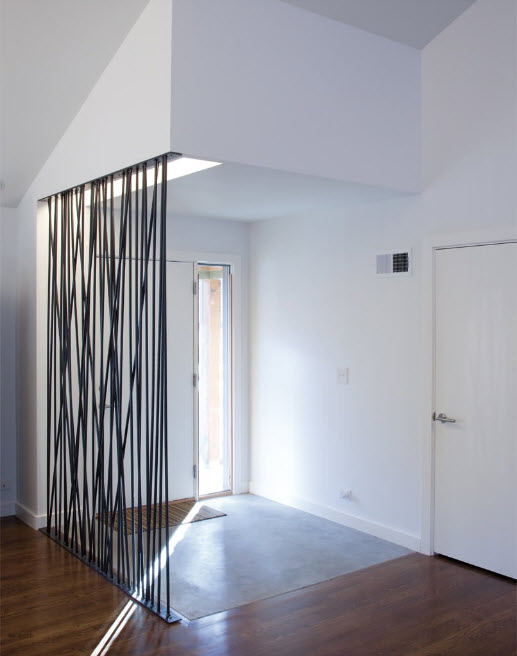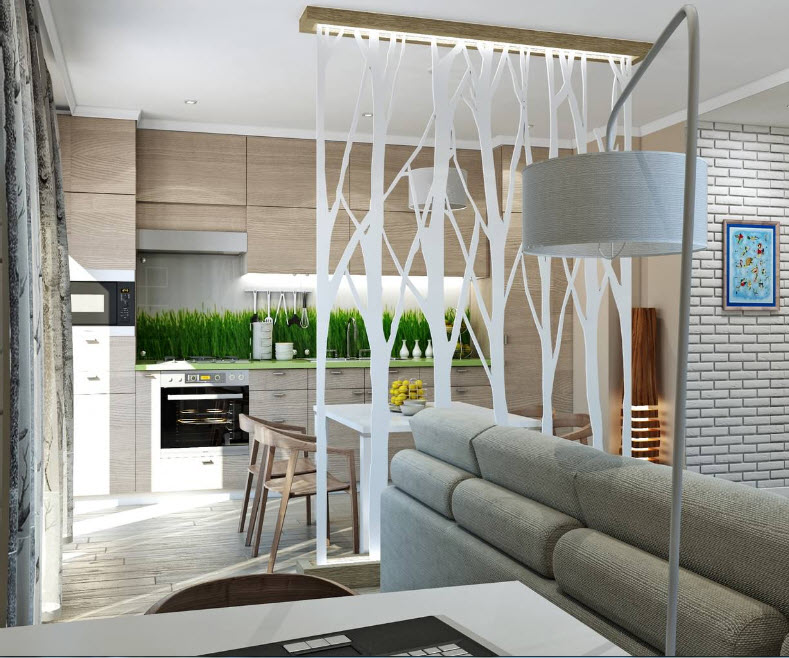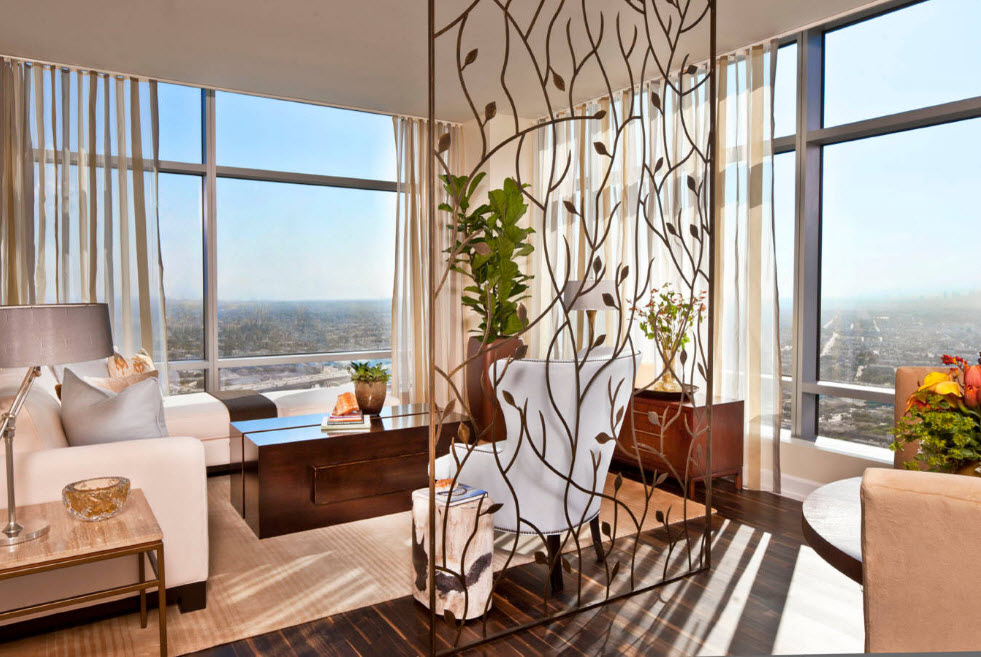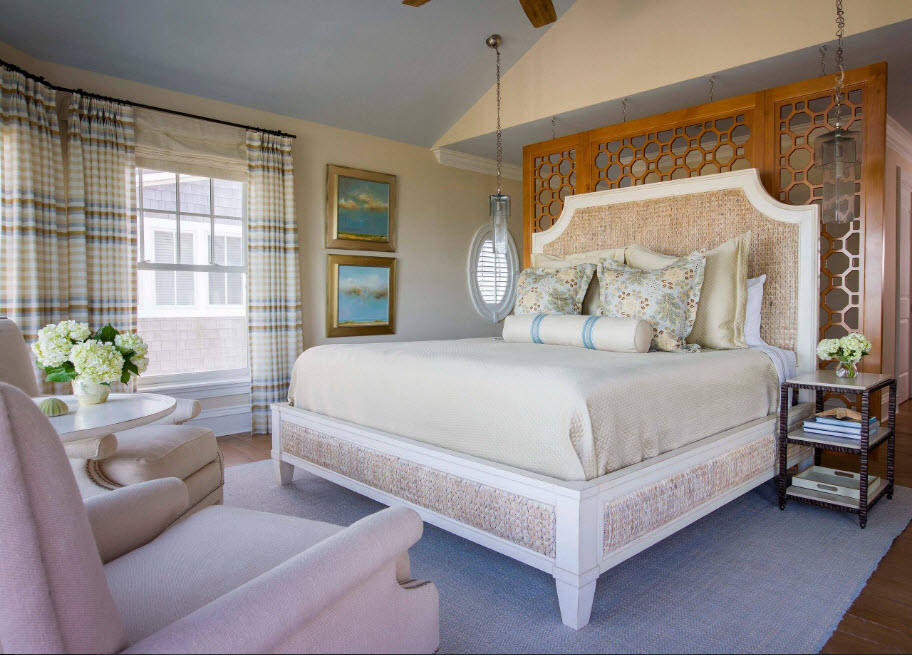Blocks for interior partitions which are better. Interior partitions: basic materials. What are accordions made of?
Apartments with free layouts, that is, without interior walls, are becoming increasingly popular. Let's figure out what partitions can be made in the apartment when such a need arises.
The meaning of free planning is that you yourself create a comfortable space for life, change it over time - for example, when children appear. No need to destroy partitions that you do not need and interfere - you initially create an apartment for yourself.
But sooner or later, the question will arise with the zoning of the space - to make a nursery or an office, or it can close the dressing room or separate the kitchen and living room.
Consider the most popular options for materials that are most often used to create in-house partitions. In fact, there are many options, but we will not talk about exotic or purely decorative solutions. We need the walls - strong, even, of available materials.
There will be four options. Let's start with the most thorough.
Brick wall
Bricks are solid, hollow (with holes inside) and clinker. If you build a partition of brick, then you should be prepared for the fact that it will take a long time, there will be many wet processes.
For 1 square meter of partition, you need about 55 bricks and a large amount of mortar, which still needs to be mixed correctly. Without special knowledge and skills, building a brick wall on your own will not be easy, it is better to entrust this business to professionals.
The wall will have to be aligned with plaster or sutured with sheets of drywall. Brick brick partitions usually do not plaster, but such a brick is much more expensive than usual.
If prices for ordinary bricks start at 7 rubles apiece, for brick already from 17 rubles.
A brick wall will be heavy - you need to calculate the load on the floor, strengthen it, especially if you live on the top floor. This can be done by professional designers and builders. The floor load will be about 30% less if you build a wall of hollow bricks, but the sound insulation performance will also decrease.
The advantages of such partitions are also noticeable:
- The brick wall is eco-friendly and very durable. You can hang any heavy objects from such a wall, hang a wardrobe, a large TV or a domestic water heater in the kitchen or in the bathroom. If the brick is hollow, additional protection of the fasteners is done.
- A brick partition will absorb sound well. This option is suitable for the bedroom.
- The brick has excellent moisture resistance indicators, the brick of water is not afraid, respectively, it is applicable for the bathroom.
one square meter partitions brick without finishing (with plaster, primer, materials) will be from 1900 to 2200 rubles.
Tongue-and-groove gypsum partitions (GWP)
Crested gypsum board is a practical, modern building material. To connect from two ends of the slab ledges (ridges) are made. There are grooves on the other two sides of the structure.
There are 3 types of GWP: corpulent, hollow, and moisture resistant.
Moisture-resistant GWP is usually green.
The advantages of such partitions:
- Due to their viscous structure, GWPs are suitable for mounting furniture structures on them. Compared to bricks, they lose, but it’s quite suitable for hanging shelves and a TV.
- The gypsum board is flat. In order to paste over the partition with wallpaper, it is enough just to ground it.
- Plaster blocks have good sound and heat insulation.
- Installing a wall of GWP is not as time-consuming as that of brick. If you wish and have the tool, you can make such a wall yourself and not spend money on the services of a construction team.
- Like brick, gypsum is a natural material. The partition will be environmentally friendly. This is especially important for the device of a children's room and bedroom.
The estimated cost of the device one square meter partitions from tongue-and-groove gypsum boards without finishing (with plaster, primer, materials) will be from 1700 to 2000 rubles.
The disadvantages of such structures in comparison with masonry - in reducing the level of strength.
Foam concrete and aerated concrete
These are cellular concrete materials that have become an excellent alternative to masonry. They are cheaper and easier, from such blocks it is faster and easier to assemble a wall. During installation, special glue is used, the consumption of which is much less than that of a sand-cement mortar for a brick wall.
Aerated concrete is divided into foam concrete and aerated concrete, the difference between them is in production technology. Aerated concrete is stronger than foam concrete, since it is usually processed in an autoclave furnace, and foam concrete is gaining strength in shape in the air.
Blocks are easy to saw and give the desired forum: in such partitions it is enough to simply install doors, cut an arch, drill grooves for wiring.
The disadvantages of gas and foam blocks are in the low level of strength. A load of more than 20 kg on a partition of such blocks is not recommended. Because of their porous structure, the blocks absorb water, do not use them in the bathroom. In any case, such a wall must be primed and plastered - and only with special plaster for aerated concrete.
The estimated cost of the device one square meter partitions from aerated concrete comparable to the device partition from GWP.
Plasterboard partitions
A familiar option for the device of interior walls.
The advantages of this method:
- Low cost of materials and ease of assembly. It’s possible to do it yourself, there are a lot of detailed instructions on the Internet, you can buy the necessary materials and accessories for repair in any online store.
- Drywall partitions are the lightest. A sheet with an area of \u200b\u200bone square meter weighs from 25 to 50 kg and does not create a significant load on the supporting structure.
- Drywall has a flat surface, it does not need to be plastered.
Sound insulation depends on the thickness of the sheet and the filler. Traditionally, for the soundproofing of interior partitions, fiberglass or basalt wool, polystyrene foam sheets are used.
Disadvantages of drywall:
- Fragility - such a wall is easy to damage.
- Do not suspend heavy structures. Drywall wall can withstand no more than 15 kg. If you want to hang a cabinet, you need to strengthen it with plywood and strengthen the fasteners.
- Low moisture resistant characteristics.
The estimated cost of the device one square meter of drywall partition without a fine finish with all materials will be from 1500 to 1800 rubles.
Each of the options is good in its own way. Choose what is best suited for specific tasks - to make an inexpensive temporary option with easy dismantling later or immediately build a solid wall and spend money on high-quality materials. The main characteristics of the options considered are in our summary table, not claiming absolute accuracy, but showing the pros and cons of materials.
There are a huge number of designs of interior partitions, you can apply them regardless of the materials from which your house is built.
It is important enough to make the partitions technologically correct and to provide the appropriate requirements that will be necessary for certain rooms.
If we consider the vertical structures inside the house, we can distinguish bearing walls and interior partitions. All ceilings and roof structures are based on the former, while they themselves are based on a foundation. On the plan of the house bearing walls strictly fixed.
Interior partitions in this case will not be bearing structures. They only divide the interior space of the whole house into separate rooms. Therefore, they can be performed both from heavy building materials (for example, silicate brick), and from light (for example, wood or). From building material and the quality of the interior partitions depends on the insulation of the house, environmental friendliness, beautiful aesthetic appearance, and the possibility of future redevelopment of the space.
Basic requirements for partitions
 Interior partitions in a wooden house should be:
Interior partitions in a wooden house should be:
- strong and reliable, so as not to pose any danger to the residents of the house;
- maintain the established period of its operation;
- not have cracks and crevices on the surface or at the junctions to other structures of the house.
In addition, there are special requirements:
- For partitions in the bathroom and laundries, resistance to penetration of moist air and steam is quite important. They must be made of waterproof building materials, but the main thing to consider is to prevent moisture and moisture from entering the structure. The correct facing from waterproof building material will perfectly solve this problem;
- For interior partitions of the second floors and attic rooms in houses with wooden floors, their low weight is important, since they are able to withstand a small load than reinforced concrete;
- If you plan to illuminate the room in the back of the house, then it is better to use a translucent partition made of special glass blocks or structures with glass inserts;
- For laying the appropriate engineering communications (, chimney, etc.), a stationary interior partition of increased thickness is perfect;
- Partitions inside the house, dividing zones with different temperature conditions, must be massive and guarantee good thermal insulation.
 Typically, partitions should provide good facilities. Massive interior structures do an excellent job of this, and in lightweight partitions for this purpose soundproof building material between the claddings is used.
Typically, partitions should provide good facilities. Massive interior structures do an excellent job of this, and in lightweight partitions for this purpose soundproof building material between the claddings is used.
Sound insulation
According to regulatory requirements, the airborne noise isolation index should be at least 43 dB for partitions between rooms, kitchen and room, bathroom and room.
The higher this indicator, the better the interior design prevents the distribution of home noise - from colloquial speech to TV and radio. Although it does not include the isolation of low-frequency sounds from a home theater speaker system or working construction equipment.
With the same indexes of airborne sound insulation, a thickened partition perfectly restrains low-frequency sounds than a thin frame one.
An important point is the holes in the partition (for example, the gaps in doorway) significantly reduce the level of sound insulation.
There are a lot of different nuances in matters of the speaker system, and if you need to perfectly soundproof the rooms, contact acoustic engineers.
Standard types of interior partitions in a private house will provide a fairly comfortable level of sound insulation. Structures from thickened and at the same time porous building materials such as ceramics, gypsum concrete, shell rock - very well absorb and reflect any sounds. These partitions have a thickness of 10 cm and provide an acoustic insulation index of 40 dB.

Drywall Partition Covering
In order to improve the sound insulation of systems from these materials, a special air gap is made between two rows of masonry or the wall is additionally covered with drywall.
Multilayer structures are also quite effective, their outer hard layers reflect sound, and combine with soft layers that absorb it.
The interior partitions made of gypsum concrete are several times lighter than brick ones and have a flat and smooth surface.
The thickness of this design from one layer of plates will be only 10 cm. If you need to increase the sound insulation of a room or lay pipelines in the interior partition, it must be double.
Installation of this system begins with leveling with a cement-sand mortar, then special waterproofing from roofing material is placed under the lower blocks.The template is made of two racks with a moving rack. Usually the plates are mounted on top of each other with the long side strictly horizontally, with the dressing of all the seams. Apply a gypsum solution. Metal reinforcement is laid in all horizontal seams and fastened to walls that limit the interior partition. The gap between the ceiling and the interior partition is sealed with a special gypsum mixture. Plastering plates is not necessary, just putty enough.
An important point, the gypsum mixture must be prepared immediately before its use, since it hardens very quickly. And all the metal rods that are installed between the rows of plates must be treated with a special bitumen varnish.
In new homes, before installing partitions, it is advisable to wait several months after installing the supporting structures of the house, so that their necessary shrinkage occurs. The interior partitions in the house are mounted before the floor is screed. Performing a screed or rough wooden flooring in the future, between the wall and the floor, a laying of 2 cm soundproofing building material is performed.
Installation of the systems begins, noting their location with lines on the floor, walls and ceiling.
Interior structures are firmly connected with the ceiling at the base and proximal walls.
Wooden partitions
Currently, two types of partitions are used in frame house using wood - it is solid and frame. 
Wooden partitions are used in houses made of different materials, without reinforcement wood flooringThey are perfect for the second floors of houses and attic rooms. Such structures are easy to mount and dismantle, so they are ideal if you plan to redevelop in the future. In rooms with increased humidity, wooden partitions must be protected with waterproof.
Solid partitions made of wood are released from vertically standing boards. To enlarge the boards are mounted in two rows, distributing between them a soundproofing material or an air gap. The disadvantage of this design is the high material consumption and, as a result, the cost, as well as the large specific gravity in comparison with the frame interior partitions.
 Structural systems based on a wooden frame are made of beams and upper and lower harnesses. Between the wooden racks of the frame, sound insulation plates are installed.
Structural systems based on a wooden frame are made of beams and upper and lower harnesses. Between the wooden racks of the frame, sound insulation plates are installed.
Installation of these partitions in the house with your own hands is carried out as follows: at the base of the interior partition, a special beam is laid, which is firmly supported by the floor beams. To form a continuous structure on the harness, two horizontal guides must be fixed, between which the boards are vertically fastened, connecting in the upper part with a fixing wooden block.
When installing the frame partition on the strapping, the racks are placed with a certain step, combining them with the upper strapping. Details and elements of a wooden frame are fixed between themselves by nails or self-tapping screws, using metal corners. On the one hand, the lining is installed, and after that the space between the wooden beams is filled with sound insulation. The structures of the wooden frame are fixed to the walls using metal crutches, to the sheathing using self-tapping screws.
At the junction of the partitions with adjacent structures, you need to fix a special metal mesh. This will protect the entire structure from cracking.
In a wooden frame house, interior structures must be installed one year after the construction of the house, i.e. after its considerable shrinkage. The distance between the top of the interior partition and the ceiling should be at least 10 cm. It must be filled with tow and covered with triangular bars.
Drywall partitions

Drywall Wall Partitions
The modern system for the installation of gypsum plasterboard partition walls allows you to perform construction work especially quickly.
Lightweight drywall partitions in the house can be used from different designs and building materials and in any other rooms, even with increased air humidity.
The structure of this system includes metal profiles - horizontal guides and vertical posts and a special soundproof building material.
Use structures with different layers of cladding, as well as on a double metal frame. The sound insulation level of the interior partition depends on the total number of sheathing sheets, the total thickness of the internal noise insulation layer, and the presence of an air gap.
These structures are mounted during finishing work prior to installation. Polyurethane sound-insulating tape is glued onto horizontal metal profiles, and they are fixed to the floor and ceiling with dowels and screws. Rack metal profiles are installed in increments of 60 cm. The skin of the frame must be fixed on one side with self-tapping screws, and it is imperative to put soundproof material between the metal profiles. After that, the lining is installed on the other side of the partition. All the roughness and roughness of the lining, as well as the hats of the screws, must be sealed with putty.
For a better quality of sound insulation, partitions are installed to the supporting structures of the ceiling and only then drywall is laid. All seams between plasterboard sheets should be putty in several stages.
Glass partitions

Glass interior partitions
To create these interior partitions, glass blocks are used, which differ among themselves with a huge palette of various colors, a choice of surface textures and original sizes.
Glass interior partitions are used so as not to restrict the access of natural light to rooms located in the depths of the frame house.
All glass blocks look like hollow "bricks" with walls of transparent or colored glass. Due to the presence of air inside them, they have excellent soundproofing properties and transmit up to 80% of daylight.
Installation and installation of glass blocks as follows: blocks, as a rule, are laid at the final stage of finishing the room, but before the final decoration of the walls and ceiling. Glass blocks are laid on a cement screed. The technological process of laying them in the wall is similar to the process masonryalthough suture dressing is not needed. The thickness of the seam is approximately 1 cm. A cement mixture or cement-lime mortar is used for laying. It is applied to the horizontal and vertical surfaces of the glass block.
The connection of the interior partition from glass blocks to the ceiling should be sufficiently elastic, using cork gaskets, since glass is a very fragile building material, and the wall may crack under various deformations.
Glass blocks are best installed on white or colored cement, then the seams will look neater.
Prices for interior partitions
The final cost of the interior partition will depend on various factors.
And fire-resistant building materials will cost more than standard materials. Also, the price can increase the quantity and quality of the final finish, base frame and soundproofing material. Installation of an interior partition is approximately 40% of the cost of all building material, and its delivery to the destination and unloading, especially when choosing heavy building materials, may be equal to their cost.
The partition in a private house can be made of brick, glass blocks, drywall, boards, foam blocks, gas silicate blocks. Each of these materials presents its requirements for the condition of the room: bearing capacity floors, the quality of the wood of which the walls are made.
Features of partitions from glass blocks
For the device of a curtain wall made of glass blocks, metal guides, special glue or cement-sand mortar will be needed. They are the binder for all structural elements. Since glass blocks every 2-3 rows will need to be attached to the wall next to which they are lined up, it is important that it is strong.
The construction of this material has a rather large weight, so you should first make sure that the floor can withstand this load. If the partition is mounted in one-story house, it is recommended to inspect the logs and lower lining trim. If this is not possible, and the building was erected many years ago, it is better not to risk it and choose a lighter material for the wall device. A similar requirement is imposed on brick structures.
Features of drywall partitions
Drywall is the best choice for installing partitions both in a private house and in a multi-storey building. It is lightweight, durable, easy to install. For the device of the wall, you will need a metal profile of two types: rack-mount and guide. These products are designed for mounting the frame. In addition, it will be necessary to purchase suspensions, self-tapping screws for GVL, and self-tapping screws SMM 3.5 / 51 mm. Of the tools you will need a jigsaw, metal scissors, a screwdriver, an office knife.
If it is not possible to use a metal profile, it can be replaced with wooden blocks with a cross section of 3/3 or 3/4 cm. To install such a frame, you will need wood screws and a screwdriver.
Features of partitions from foam concrete blocks and gas silicate
A partition made of blocks made of foam concrete or gas silicate cannot be installed in rooms with high humidity. The reason for this is the hygroscopicity of this building material. Therefore, such walls are not recommended to be built in bathrooms and showers, in kitchens, in baths and saunas.
Partition walls made of foam concrete blocks have undoubted advantages: they are light in weight, durable, have a high installation speed and low laboriousness of work. To erect these structures, you will need a special adhesive composition or cement-sand mortar. Blocks can be cut using a jigsaw or conventional hacksaw.
Recently, interest in interior partitions as a construction object is growing every day. For many developers or owners of new apartments, such questions as what the internal walls are being built from and what materials to give preference to, are not idle curiosity, but a completely explainable need. In order to correctly answer these questions, first of all, it is necessary to understand the difference between the supporting structures, which serve to transfer the load on the foundation and the walls - self-supporting, dividing the internal space into rooms. They do not take on the weight of the structural elements of the building, and therefore can be anything, depending on their functional purpose. A certain classification of interior partitions, as such, does not exist, however, they can conditionally be grouped according to some characteristics. So, according to the method of construction, they can be:
Stationary
Mobile
By type of construction:
Frame-frame
From piece material
combined
By functional purpose:
Separation of space into isolated rooms
Room zoning
Decorative
Simply put, with the help of partitions, you can redraw your future housing in your own way and manner, but it is worth considering some nuances. If you doubt the location of the structure at the moment and plan to move it from time to time in the future, then the option of frame partitions that are easy to erect and just as easily dismantled is better for you. Here, you will mainly need to pay attention to the design strength of the structure, in translation into a practical language, this means how much weight a square meter of a wall can withstand. Naturally, if you are not going to hang kitchen cabinets and bookshelves, the load-bearing capacity of 60 - 70 kg / m 2 will be quite enough, otherwise you will need a wall of material that can withstand 150 - 200 kg / m 2.

When installing stationary partitions, it will be necessary to comply with the conditions that govern the allowable weight of the load on the ceiling, it should not exceed 300 kg / m 2. From this calculation, it will be necessary to find the optimal ratio of the physico-mechanical properties of the material from which it will be erected and its mass.
Focusing on the requirements that are imposed on the design, and they can be the most varied, increased fire resistance, moisture resistance, improved soundproofing characteristics or just a design addition to the interior, one or another type of partition is chosen.
Stationary are most often used to equip a separate room of the dressing room, bathroom, etc. In these cases, it is recommended to use blank interior walls. If additional lighting is needed, window openings can be provided in the partition wall, which, as a rule, are located in the upper part of the structure. Attention is also paid to the soundproofing parameters of the structure. In order not to be unfounded, we give examples of the index value of sound absorption of some materials
Table 1
| Construction material | Soundproofing Index |
Half-brick wall + stucco | |
Cork sheet (2 - 4 mm) | |
Foam concrete D400 (100 mm) | |
Plaster (80 mm) | |
Drywall + mineral wool (52 mm) |
For reference, according to the requirements of regulatory documentation, it is not recommended to exceed the noise level of 40 dB.
Given the above, we can conclude that stationary structures should be something in between between the enclosing walls and lightweight partitions.

Mobile, they are also called transforming partitions, serve for temporary restriction and modification of space. The great-grandmother of this type of partitions can be called an ordinary screen, which was used in ancient times. By their design, they are folding, from one or several modules and sliding from a single and composite web. According to the method of attachment, they are divided into:
rail
thresholdless
In the first embodiment, a guide is attached to the floor covering, along which, with the help of a system of mechanisms, the partition moves from place to place. In the second case, the fasteners are in the upper part of the partition, so that the canvas is in a suspended position. This type of construction is very economical in terms of using usable space and is successfully used in small apartments or in rooms with cramped amenities.
Structurally, the internal walls can be made of small pieces (building blocks) and frame - frame, which of these options is more suitable for your home, only you decide, everything will depend on the purpose of the partition. An interesting solution and one can say a designer find was the idea of \u200b\u200busing cabinets, shelving and decorative shelves as interior partitions. This made it possible not only to more rationally plan the areas of the premises, but also to save usable areas.
What can be said about the choice of material? His list is as diverse as for the main walls. For the construction of interior partitions is used:
Aerated concrete blocks
Drywall of all kinds
Tongue-and-groove plates
Glass blocks
Oriented - chip panels
Etc. etc.
That is, this list can be said to be endless. Now a little specificity.
Brick partitions are mainly installed on the first floors of the building, due to the fact that it is the heaviest of all materials. Undoubtedly, such walls are strong and durable. For the construction of brick structures in the upper part of the structure, calculations will be required in order not to exceed the allowable load on the floor. You can reduce the weight of the wall through the use of hollow stone. The disadvantages of brick partitions include the high complexity, the presence of wet processes and a significant amount of construction waste. Such constructions also cannot be classified as cheap ones because of the cost, since in addition to the main works, finishing works will also be required, which also cost time and money.
Aerated concrete interior walls
Cellular concrete is a good alternative, but when
the right balance between strength and density is chosen. The positive aspects include the simplicity of processing this material, it is easily sawn and processed, which indicates that in such a partition it will be possible not only to hide the wiring and some communication systems, but also to experiment with the author's ideas of arched openings, decorative niches and other designer stuff. Due to the large format of the blocks, the construction time of the walls of their cellular blocks is minimal, which reduces the period construction work. However, when choosing this material, it is worth considering the fact that the structure of pore formation in gas silicate and in foam concrete is different, this is significantly reflected in their physical and mechanical properties. So the cells of gas blocks are open in nature, which perfectly affects the air and vapor permeability of the material, but on the other hand, open pores increase its hygroscopicity. therefore finishing work such partitions require additional surface treatment. The technology of foam blocks implies the creation of closed pores, so this material has the best soundproof and moisture resistant properties to the detriment of air exchange.
Interior walls made of tongue-and-groove plates

The most flattering reviews received tongue-and-groove plates. They are made on the basis of gypsum or gypsum cement - pozzolanic binders and have a perfectly smooth surface. Thanks to it and a kind of lock, such as a spike-groove, the installation of the interior wall is reduced to a simple assembly of the plates among themselves, in addition, after assembly, you can do without applying plaster. Guides in the form of a groove and a ridge will ensure the straightness of the structure in any case, which will best affect the installation time. This material, as well as cellular concrete, is easy to process, inside such slabs m you can hide wires and piping. By introducing water-repellent additives into the raw material mixture, the moisture resistance of the material is increased, which allows it to be used for the construction of partitions in rooms with high humidity. The only annoying flaw in tongue-and-groove plates is low sound insulation, which imposes some restrictions on their use.
Drywall interior walls

Partitions from drywall, although in fairness it should be noted that the views on such designs are very ambiguous. The indisputable advantages of gypsum plasterboard internal walls include lightness, prefabrication , lack of wet processes during installation and a minimum of construction debris. There are many varieties of this material, ordinary, moisture resistant, fire resistant and composite. Accordingly, each of them has its own specific properties and can be used in a variety of rooms. An important role in the assembly of partitions is played by the shape of the edge, it happens in three types:
Straightforward
Rounded front side
With a thinning edge
The use of sheets with a special edge allows butt joints to be performed almost imperceptibly and without laying reinforcing tape.
Installation of the partition is very simple, it consists of mounting the frame, which is made of aluminum or PVC profile. From its design and strength characteristics of drywall will depend on what kind of power load the future partition can withstand. The thickness of the sheets usually varies from 6.5 to 24 mm, to increase the load-bearing capacity of the wall, sometimes a double layer of drywall is used.
Glass block interior walls

Very extravagant and unusual look interior partitions of glass blocks. The effect of the uniqueness of such a design is given by the transparency of the material and the original performance of the products. They can with a glossy and matte surface, with a smooth and embossed top layer and different color schemes. This gives unlimited opportunities for the flight of fantasy and the embodiment of the most daring plans. But the installation of such beauty requires preliminary calculations, since the glass partition cannot be attributed to the lightweight design. The usual size of a glass block is 19x19x8cm, an enlarged version of 24x24x8 cm is found. The weight of a standard product is about 4 kg, so such an interior partition will not differ much in weight from a brick one. Curved glass constructions look spectacular; for completeness, you can use shaped blocks that are available in the form of semicircles and angles. Installation of such a partition will require a lot of patience and accuracy from the performer. Due to the unusual properties of glass, it is recommended to lay out no more than three to four rows a day in order to ensure the required grip and eliminate possible deviations from straightness. In no case should you leave even a small part of the solution on the surface during installation, its removal after setting can leave scratches.
The design of the interior walls made of wood is similar to the frame structure of drywall. It is based on a metal profile, which is lined with natural material on both sides. Similarly, MDF internal walls are installed, oriented - chipboards and plywood.
The interior partition can be a wall in fact, and it can burn only half the space, can be dull, transparent or even be suspended from the ceiling, can divide the room or act as its decor. In a word, how many needs does a modern owner of an apartment or house have, so many offers on the market. Made of various materials, different sizes, shapes and methods of execution - interior partitions, meanwhile, always perform an important function - they zon the room into functional segments. We suggest you familiarize yourself with the options for creating interior partitions for a wide variety of cases using our large-scale selection. At your service are 100 ideas for modern room projects with different functional affiliations.

Interior partitions - choice of manufacturing material
Depending on what function the interior partitions will perform, the material of execution is also selected. Someone needs a full-fledged wall that can bear the weight of hanging shelves or cabinets, while others need a decorative element that decorates the interior. Consider the various materials for the execution of interior partitions, their advantages and disadvantages, technological characteristics, the possibility of self-assembly and affordability.
So, interior partitions can be made of the following materials:
- brick (full, hollow, clinker, ceramic);
- drywall;
- glass blocks;
- glass;
- aerated concrete blocks;
- expanded clay concrete blocks;
- metal;
- polycarbonate;
- acrylic;
- tree (bamboo, weaving from twigs, twigs, branches);
- combination of various materials within one product.
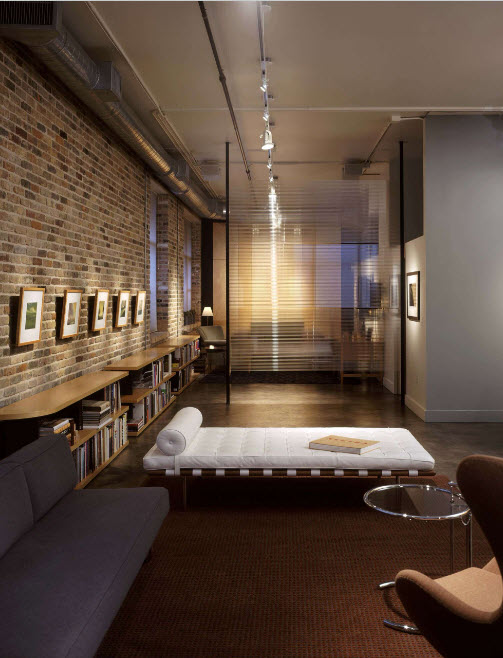
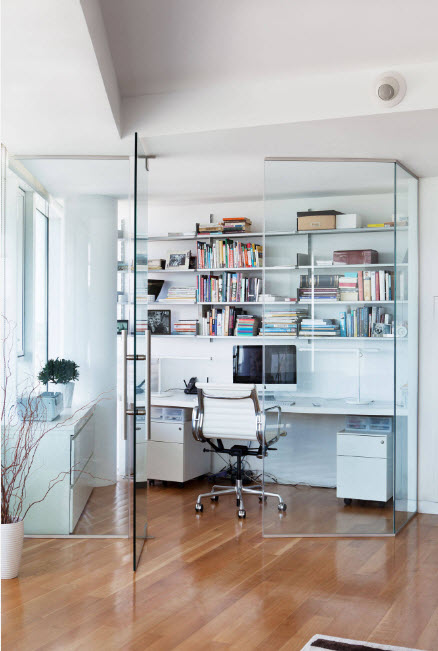
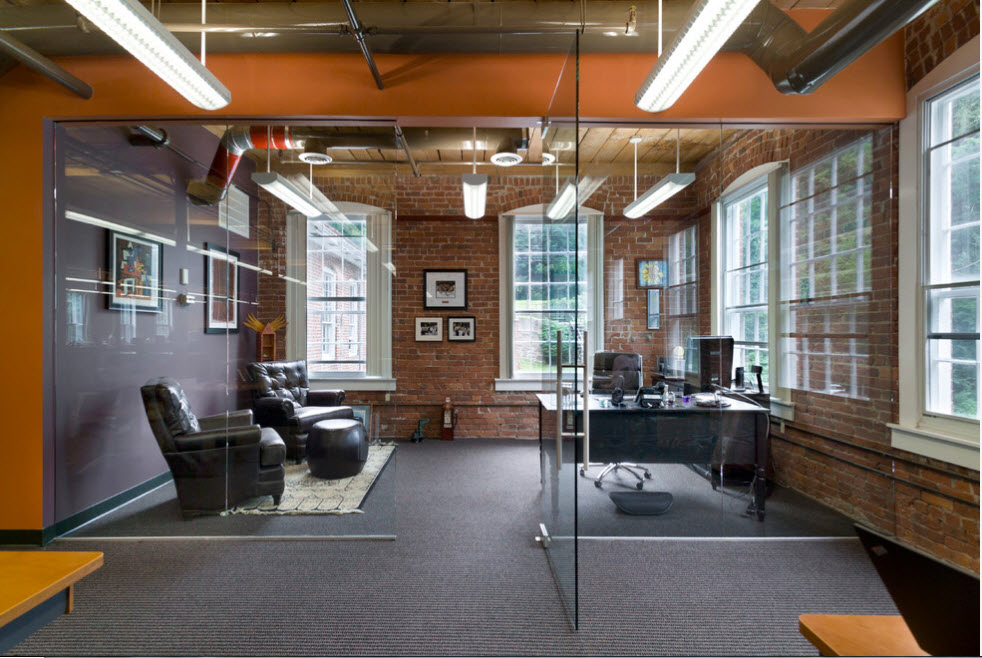
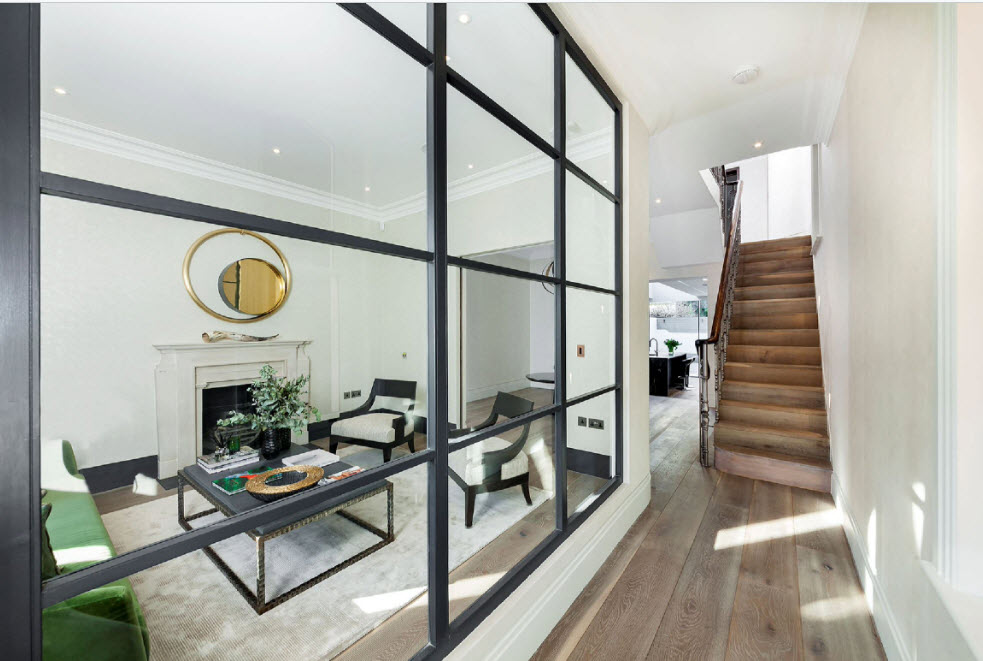

Partitions made of bricks - building, hollow and clinker
Walls, and of brick (hollow, solid or clinker), it is usually the interior walls that are erected, which are the most difficult partitions. But their properties of durability and sound insulation are beyond competition. If you need a capital partition between rooms or indoors, then a brick can be an ideal material.
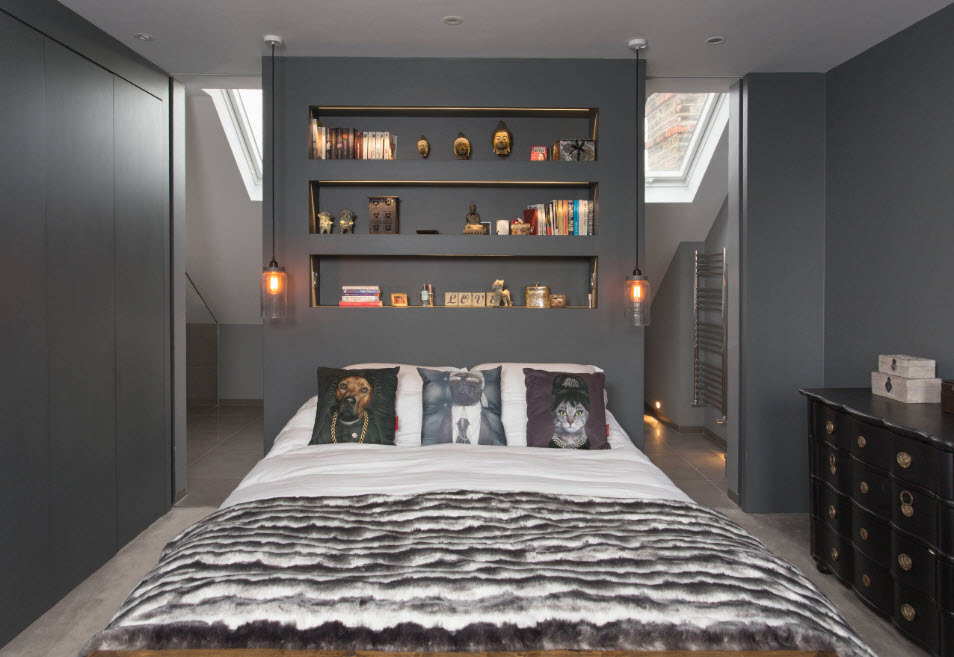
Massive cabinets and shelves can easily be hung on solid brick and clinker walls. Various structures can also be hung on partitions made of hollow material, but it will be necessary to use reinforced fasteners, as fasteners can get into the empty cavity of the product. The installation of a hollow brick wall reduces the floor load by about 20-30% compared with solid structures. But soundproofing qualities are reduced by about the same amount.


Structures made of traditional brick and clinker are heavy, so they can only be mounted on concrete floors. Specialist consultation is required, both in apartment buildings, and when erecting walls in private dwellings on the upper floors. But in any case, the lesson is rather laborious, not cheap and requires further processing - plastering, painting or gluing with wallpaper, wall panels. Clinker brick structures are usually not plastered using decorative items. But clinker structures have a high cost due to the price tag on the material itself.

Ceramic brick walls
Cheaper and faster, compared with the construction of partitions made of ordinary brick, will be the installation of walls made of ceramic products with a thickness of 11.5 cm. Indoors, walls made of light ceramic bricks can provide a fairly adequate level of sound insulation. Typically, walls from this type of building material are plastered, less often - covered with drywall. A partition made of ceramic products can withstand hanging cabinets and shelves, but for fixing it will be necessary to use special spring pins designed for porous bricks.
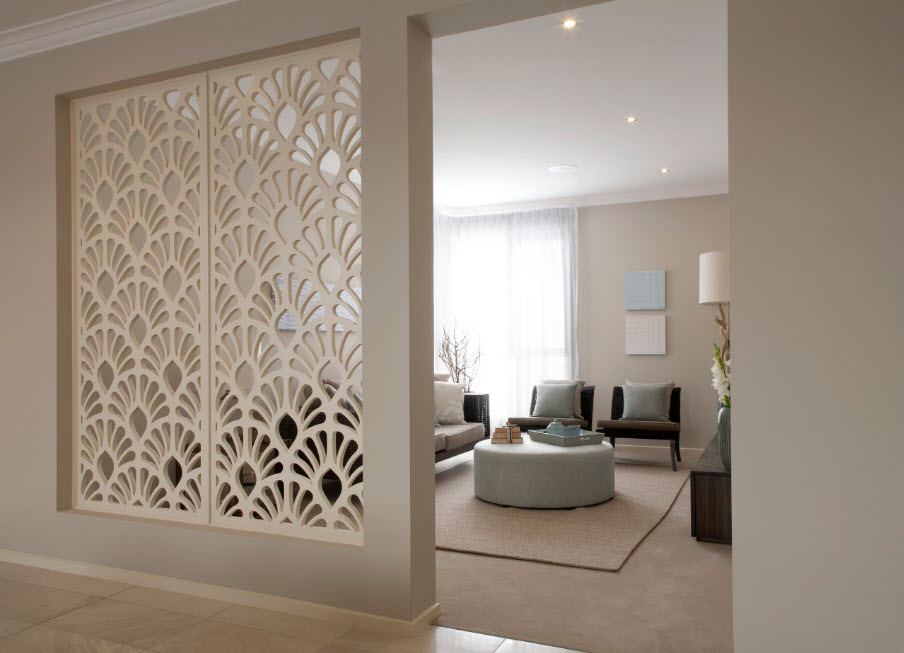
Partition from glass blocks (luxers)
Partitions from glass blocks are most often used in cases where they want to preserve (without significant loss, at least) the penetration of lighting into different functional segments of the space, but at the same time get a sufficiently strong, wear-resistant and durable interior wall. Most often, the use of this expensive material is determined by stylistic need, decorative qualities.

The construction of partitions from aerated concrete blocks
Aerated concrete or cellular blocks are a very popular material for quick and inexpensive construction of interior walls and partitions. The main advantage of the material is its high flexibility to create surfaces of various shapes. If you need an original partition with smooth lines, original holes or just with internal wiring - aerated concrete products will be the best choice.

Compared to any type of brick, cellular concrete partitions have the worst soundproofing properties. But, if you do not have a goal to protect one zone from another from the point of view of penetrating noise, then this simple installation material can help to quickly create the desired partition.

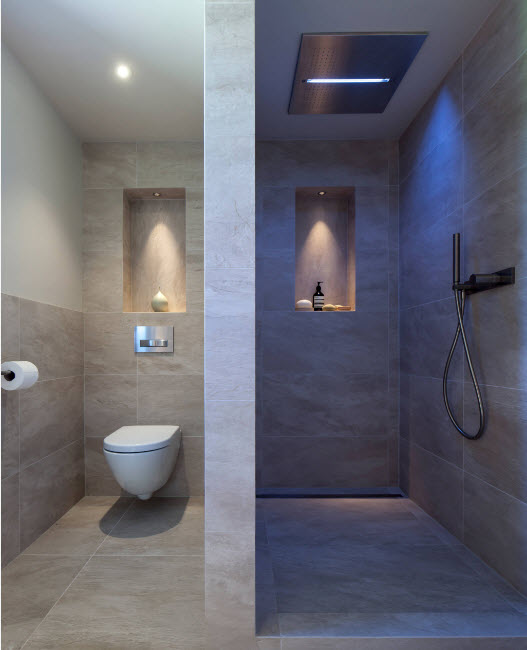
Expanded clay blocks for interior structures
Expanded clay partition walls are easy to build, they have sufficient strength to hang shelves and cabinets (but still less than brick walls), have sufficient wear resistance and durability. In addition, expanded clay concrete products perfectly absorb sound.
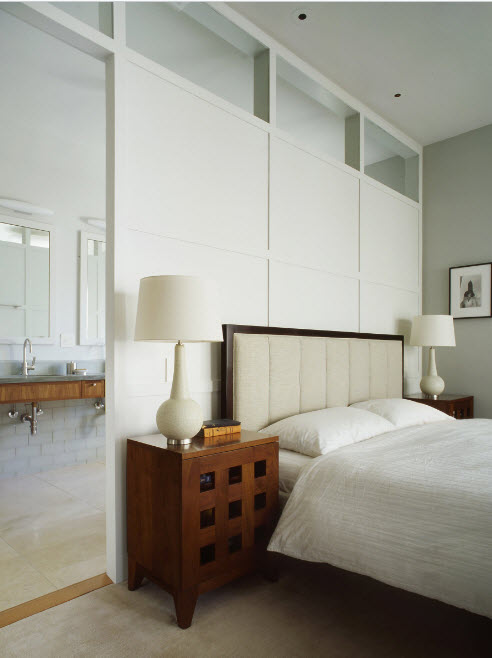
A partition made of expanded clay blocks can be mounted using ordinary mortar and plastered with the so-called ecological plaster - clay, lime, gypsum or cement. At a cost, such a design will cost less than a wall of ordinary concrete blocks.
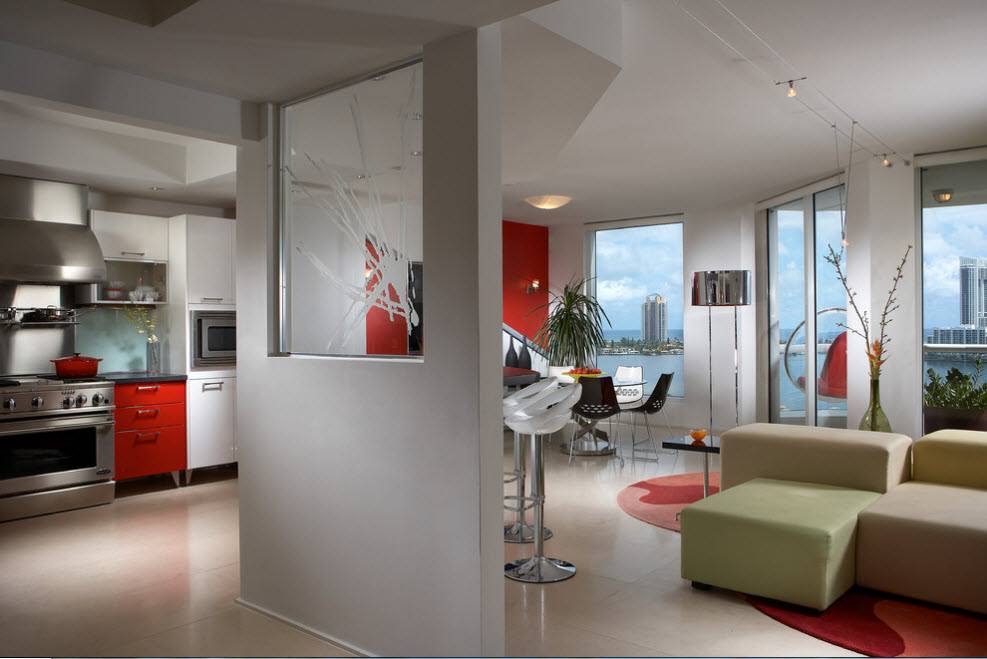

Modern drywall partitions
A fairly popular way to create partitions of various modifications is to use drywall products. Recently, the use of moisture-resistant panels has been effective, which can be installed even in bathrooms and toilets. Typically, a partition consists of two drywall panels mounted on a metal profile: mineral wool filler can be laid between them. As a rule, the thickness of such partitions does not exceed 10-12 cm, but may be smaller.


If we talk about the positive qualities of drywall partitions, then their presence in the rooms favorably affects their microclimate - the structures are able to absorb and give away moisture that is contained in the air. Such partitions can be erected very quickly, besides they do not require plastering, only putty joints.


Heavy objects cannot be hung on drywall. If such an action is necessary, then the fastening elements must be inside the structure itself, mounted to metal profiles. Another disadvantage is the low impact strength (which is why drywall partitions are not used in children's rooms).
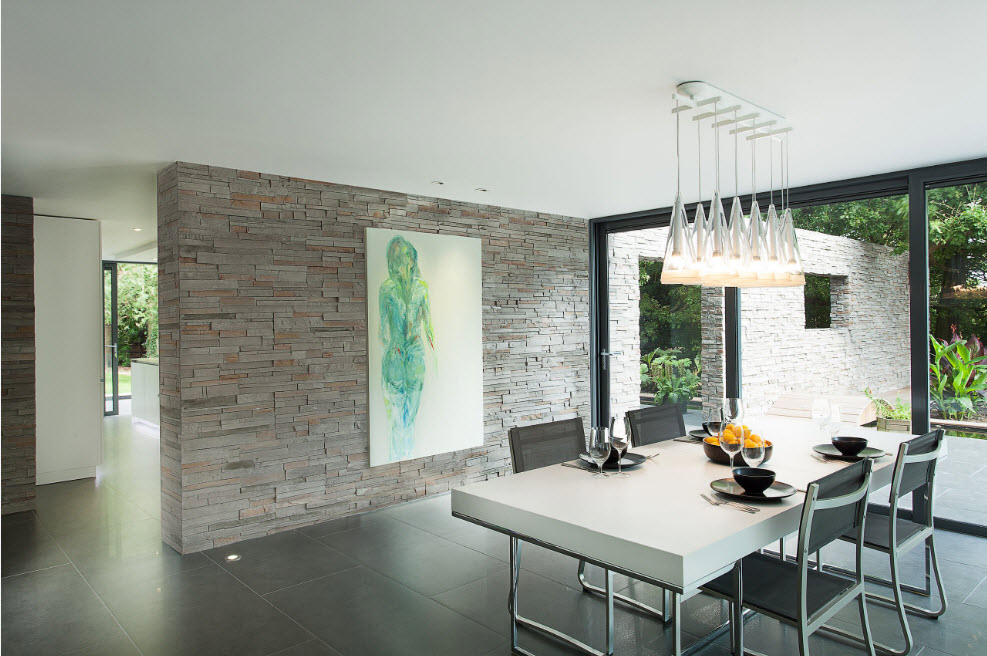
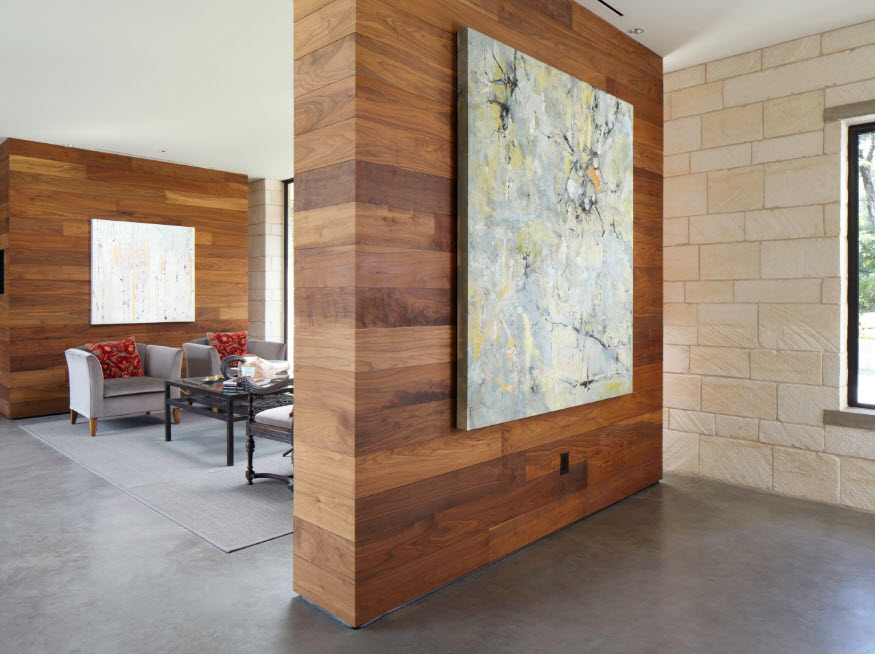
Partitions from a tree of various breeds
An interior partition made of wood of one or another modification can be either a very expensive product or it can cost you practically nothing - it all depends on what kind of wood it is made of, or you used waste material. In any case, wood products always bring notes of natural warmth, comfort and uniqueness to the interior.
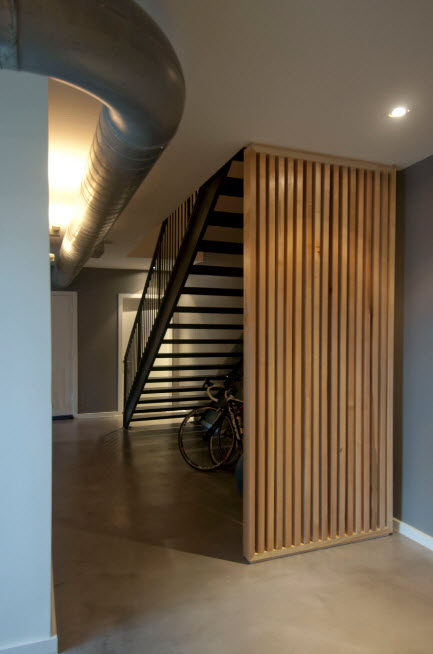
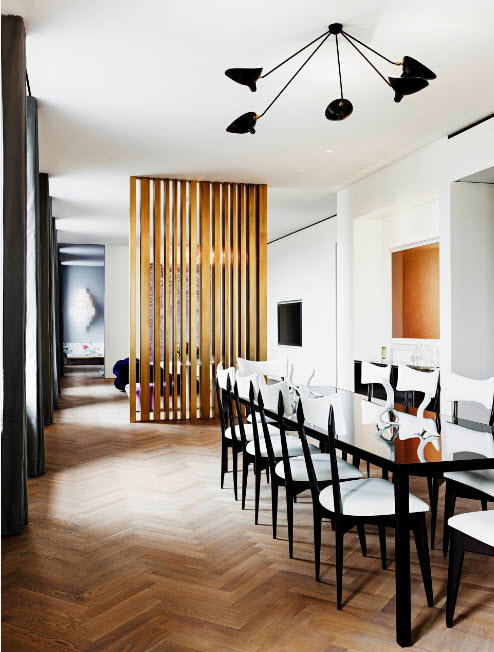


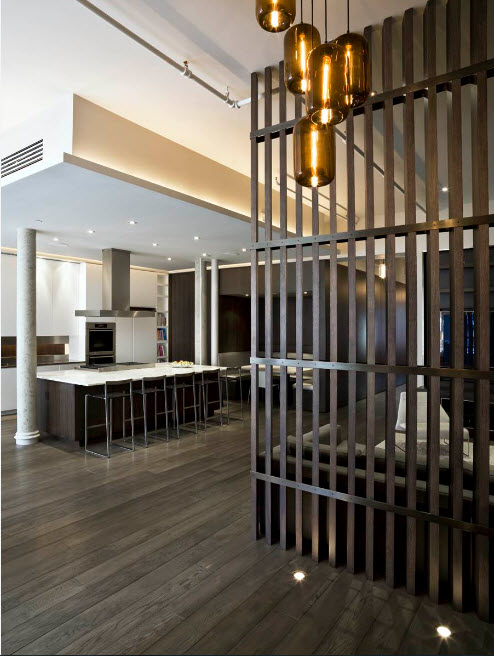
Most often, wooden partitions appear in their natural color scheme with a beautiful natural pattern ...
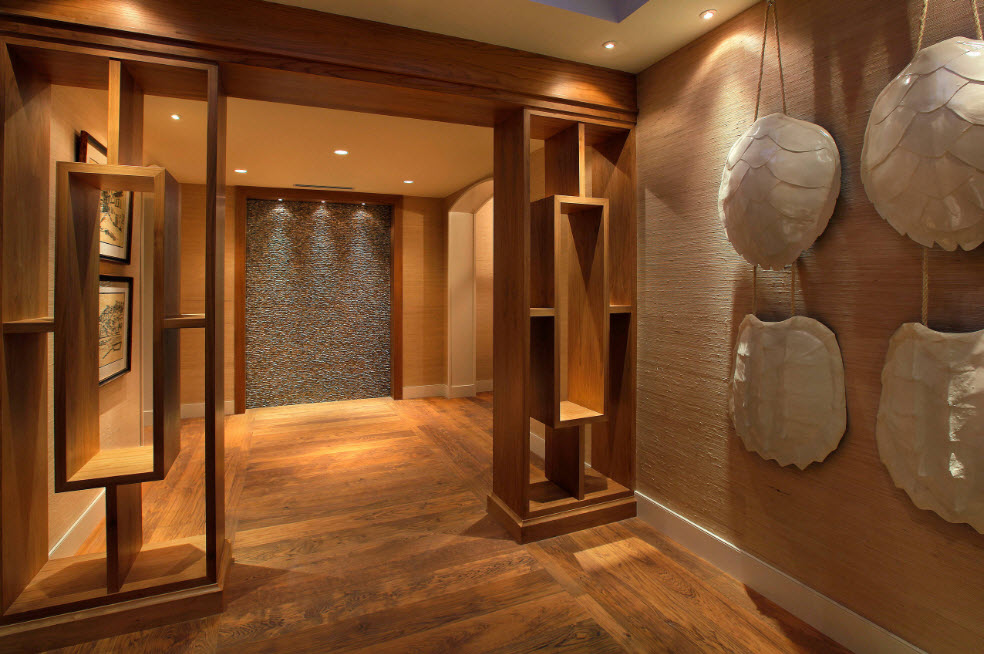
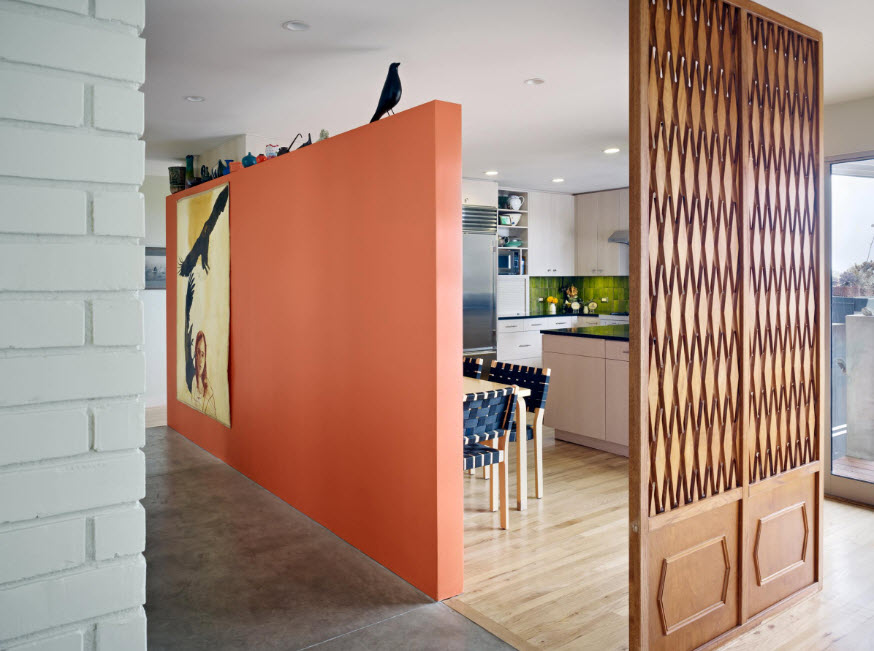
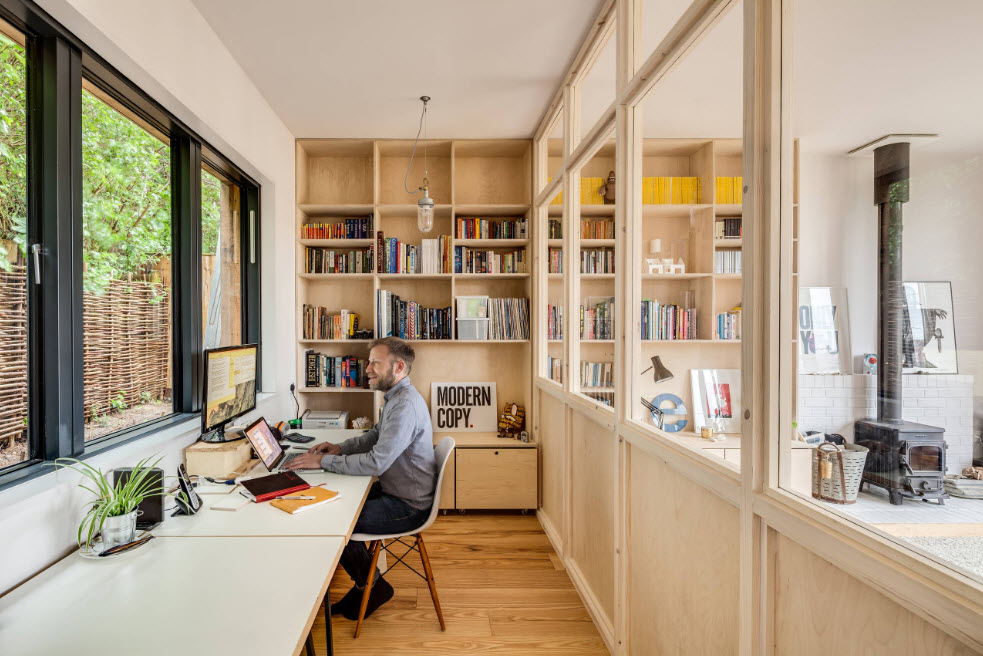

But there are situations when painting a wooden partition or its elements is necessary ...

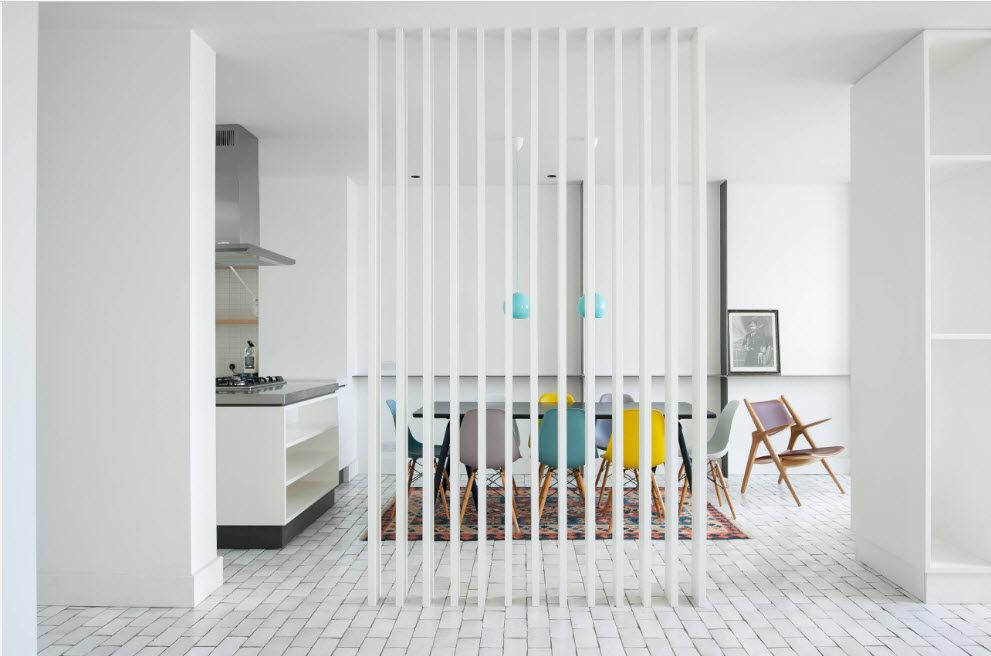
The same group of interior partitions made of natural material include various constructions of bamboo, vines, branches, twigs and other plants. Exclusivity of the interior with similar zoning elements will be provided to you.

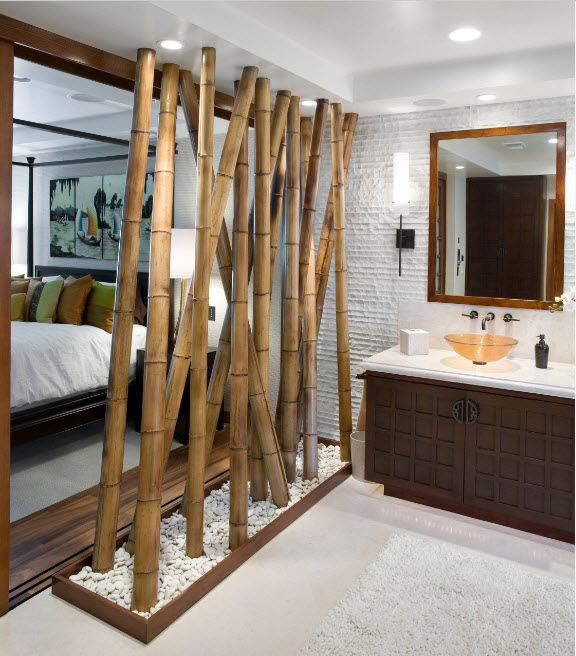

Glass partitions - transparent and matte
Glass partitions are used in cases where it is necessary to create a clear zoning, while maintaining the distribution of light in all functional areas of the room. As a rule, for the manufacture of transparent or opaque partitions, toughened glass, which is especially strong and safe for humans, is used (even when breaking the surface, a person will not be injured by fragments due to a special protective film that prevents the glass from flying apart).

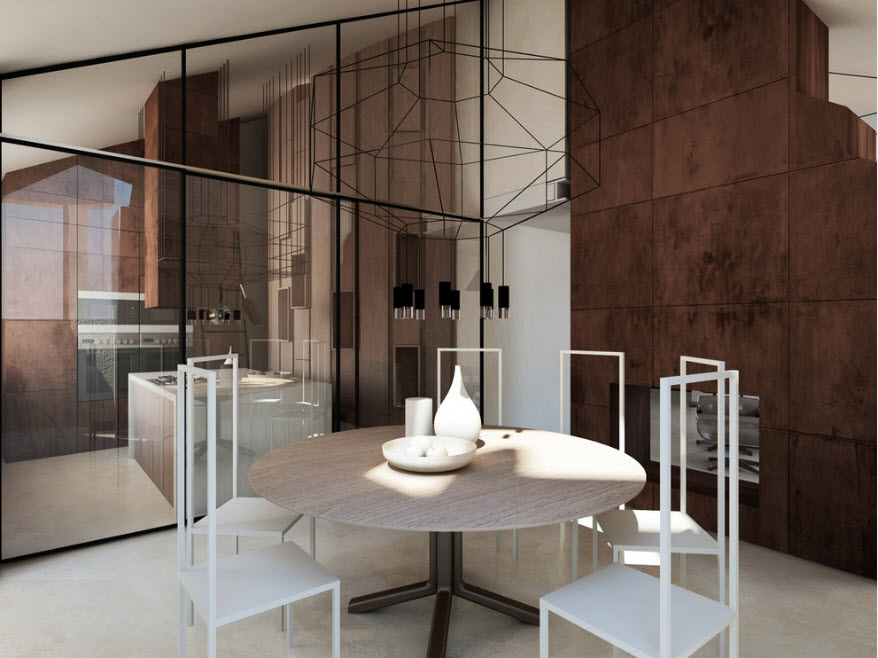
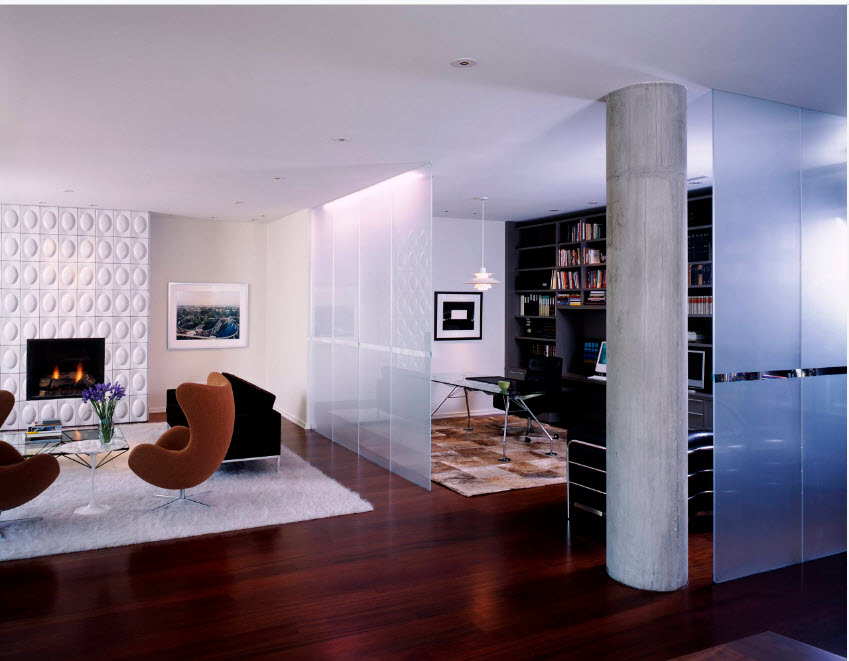
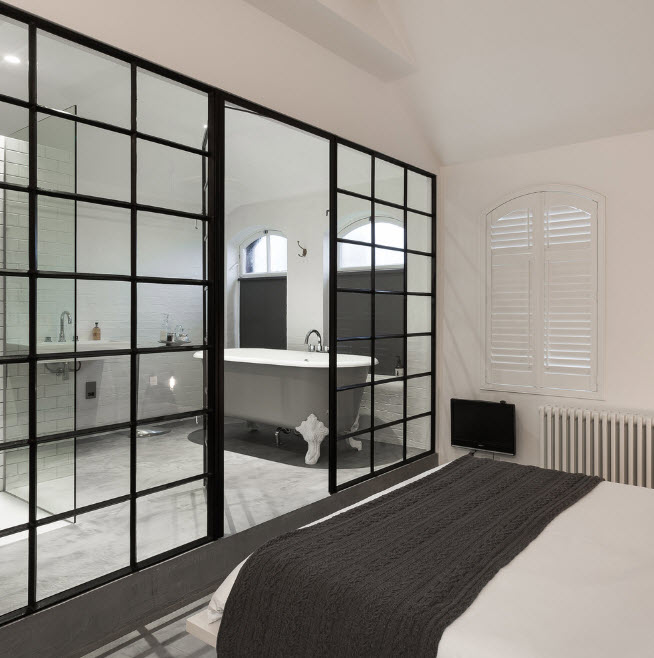
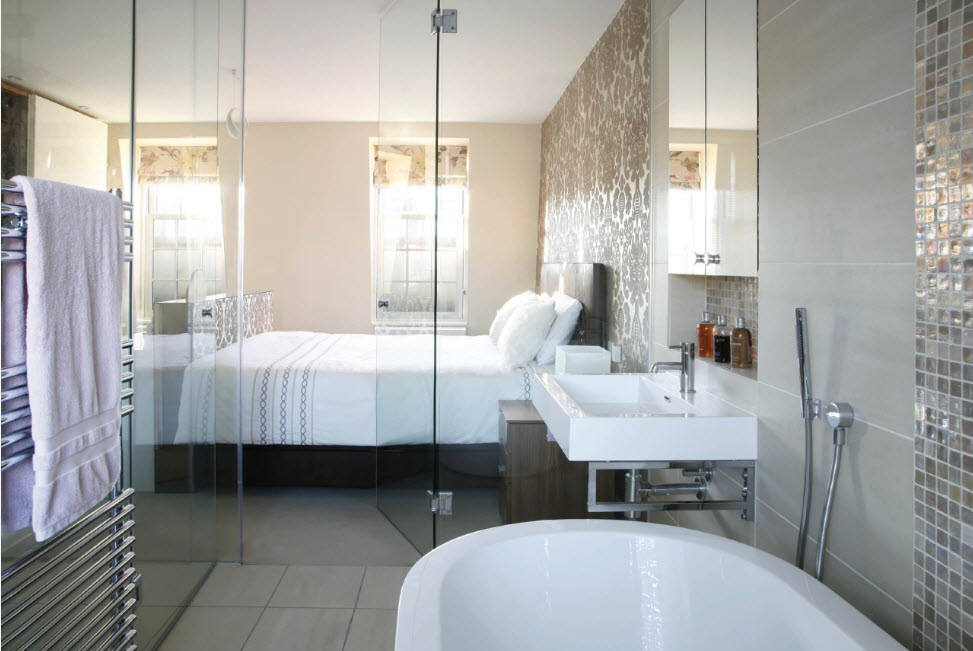

Most often, glass partitions can be seen in bathrooms and toilets. They can protect the shower area from the rest of the room or divide the room into a toilet and a segment for taking water procedures. In modern design projects, you can increasingly find the use of absolutely transparent glass to create small partitions. But also matte products, surfaces with a pattern and photo printing are found as a decorative element of the interior, which, meanwhile, performs its main functions.
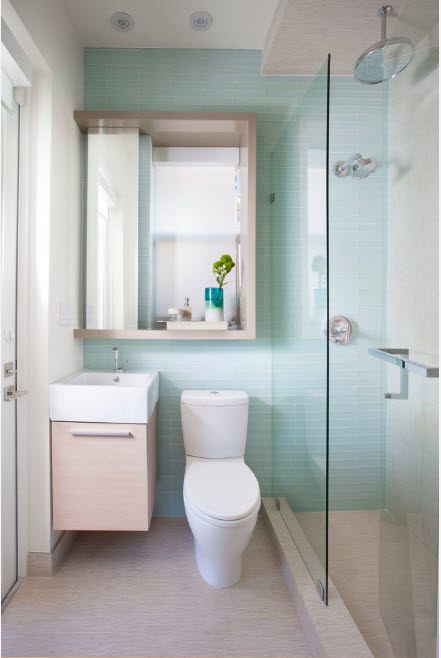
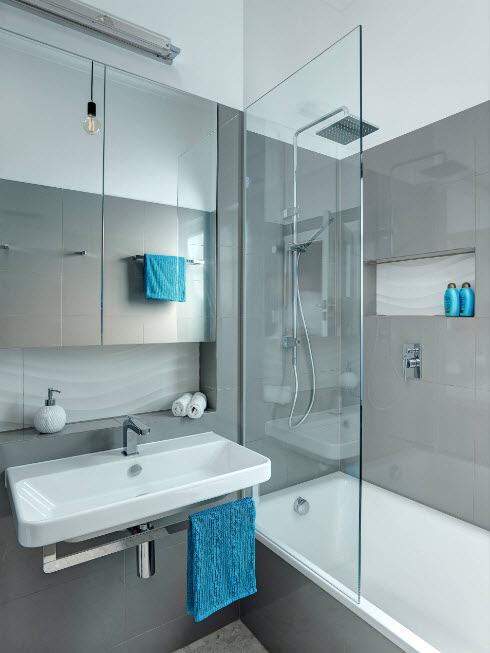


Partitions in the form of glass sliding doors can reliably fence off one of the functional segments located in the common room. Excellent soundproofing qualities, the almost complete distribution of light fluxes and the ability not to burden the image of the room make this type of partitions very popular. Although it is expensive and requires the participation of specialists.
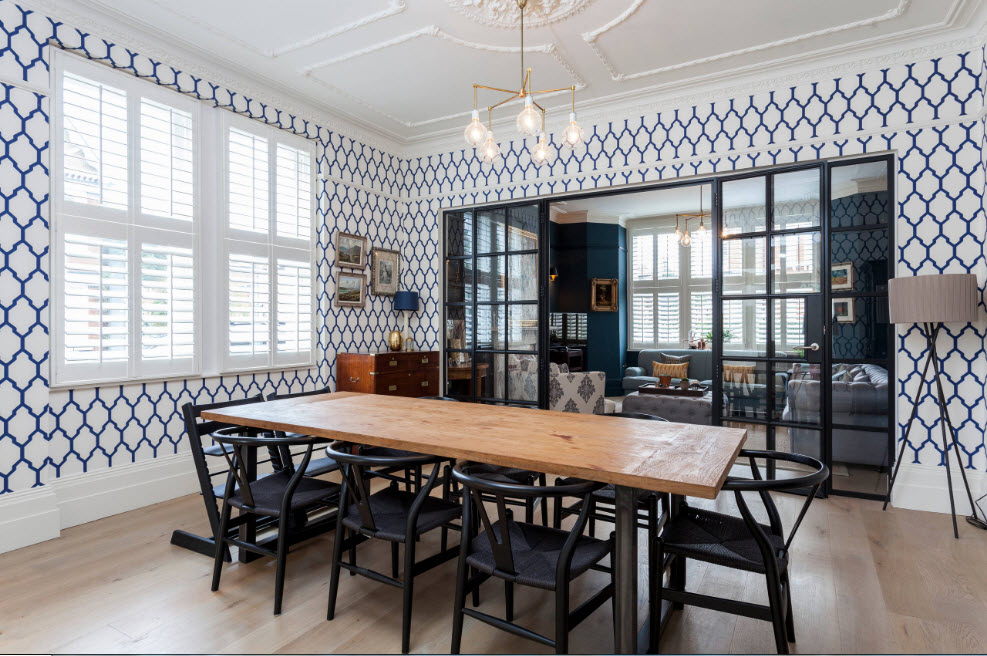

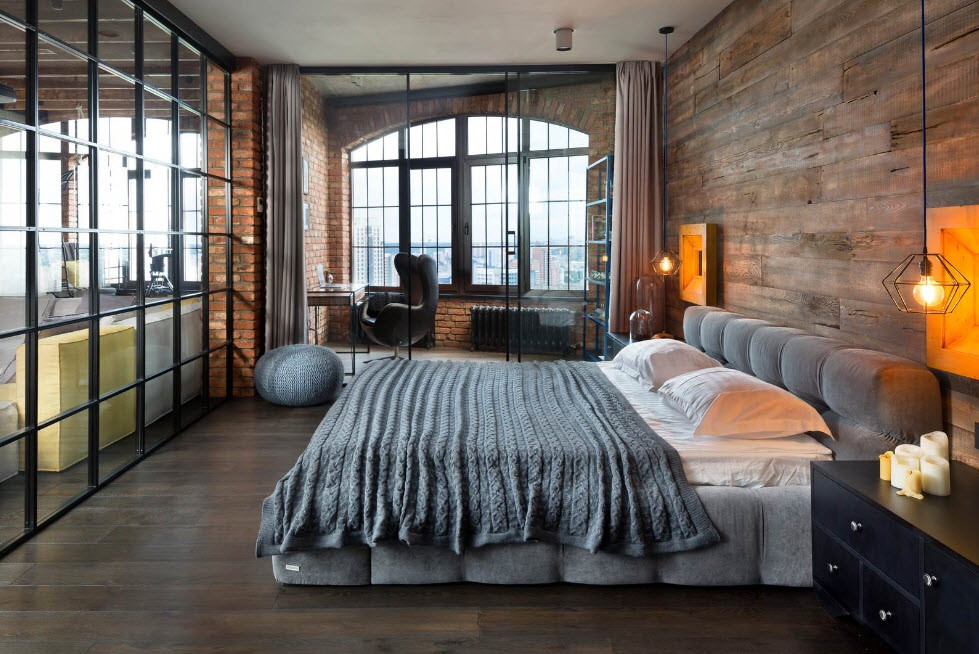


Glass partitions with a pattern, laser engraving, photo printing or stained glass made using the technique can not easily decorate the interior, and become its highlight.

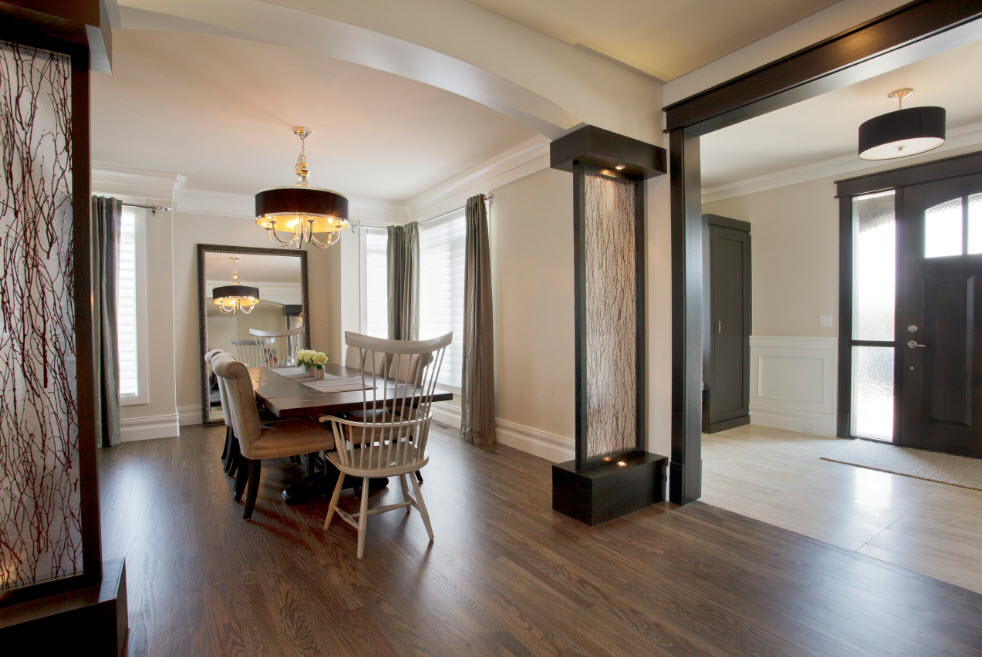

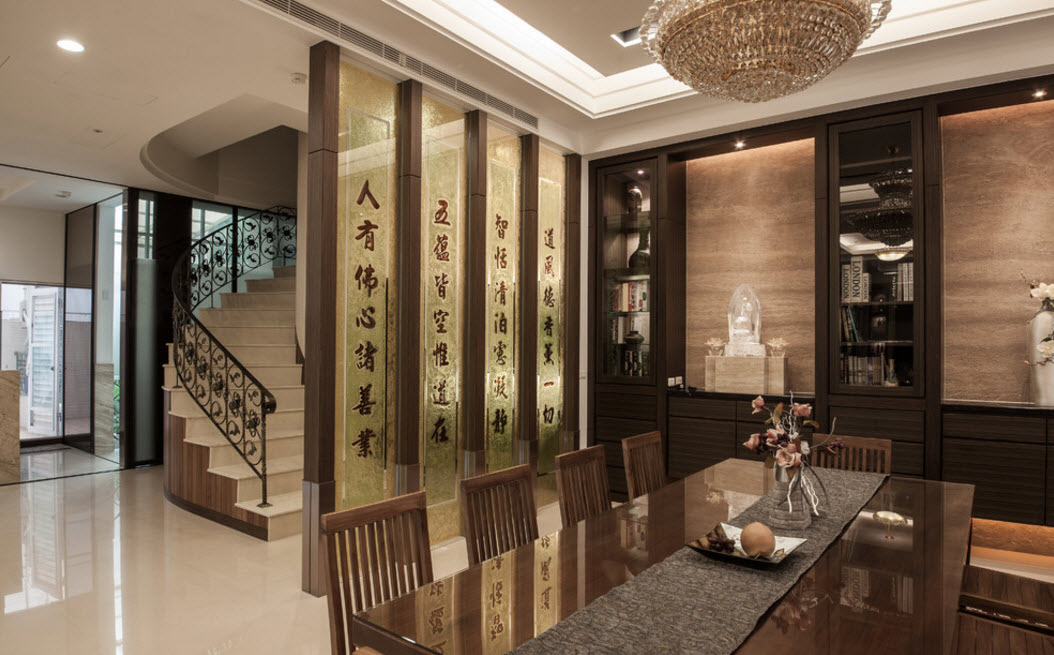
Examples of combining materials to create original partitions
One of the most common unions of various materials for creating partitions is the use of glass inserts for a metal or wooden frame. Such partitions perfectly transmit light, but have good sound insulation. Such a combination is important if you need to separate, for example, an office from the living room and soundproof it, but at the same time be able to keep track of children in the adjacent functional segment.

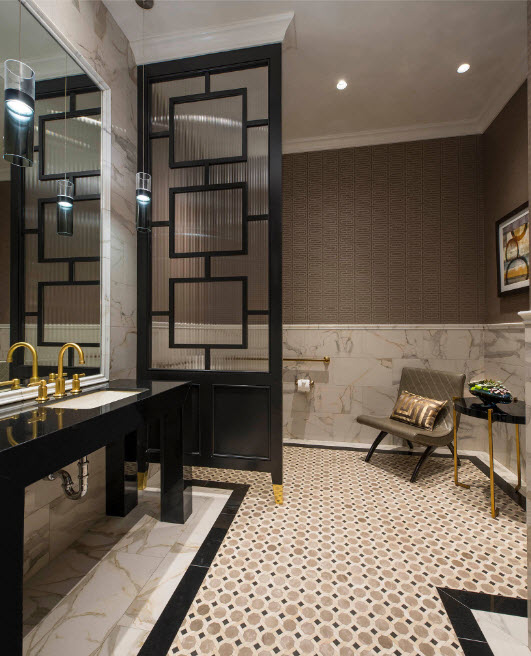
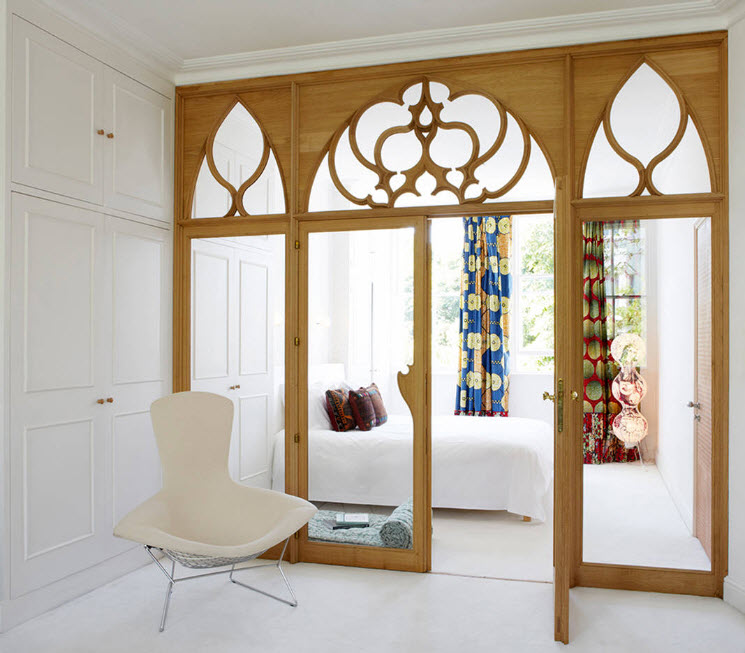
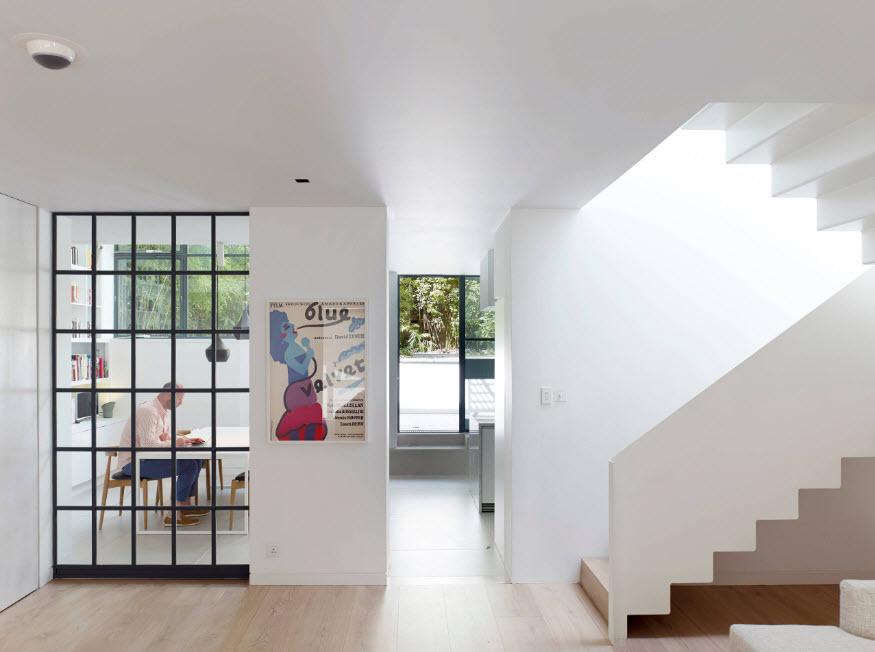
Shelving partition
A great combination of functionality and aesthetics is the use of a rack (and not necessarily a bookcase) as an interior partition. An effective storage system and a beautiful element of the interior, which, among other things, zones the room. The advantage of such structures is also that they can be equally effectively used on both sides of the zoned space.

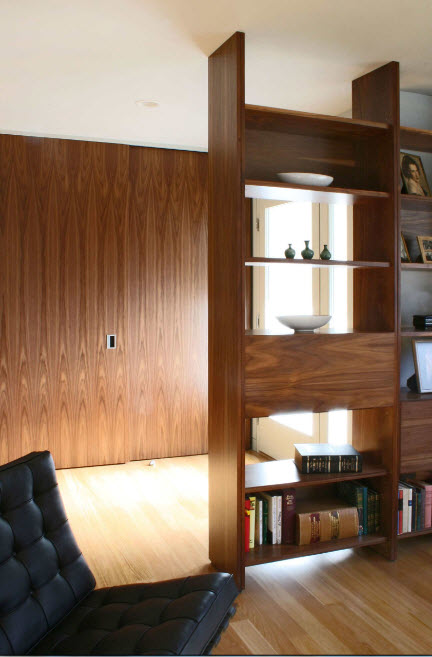
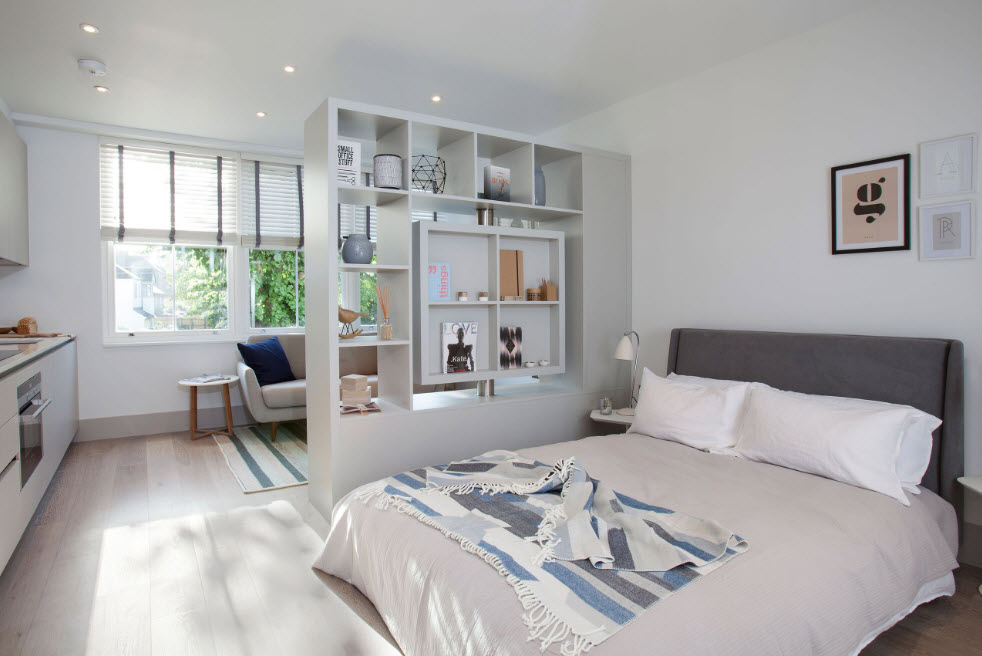

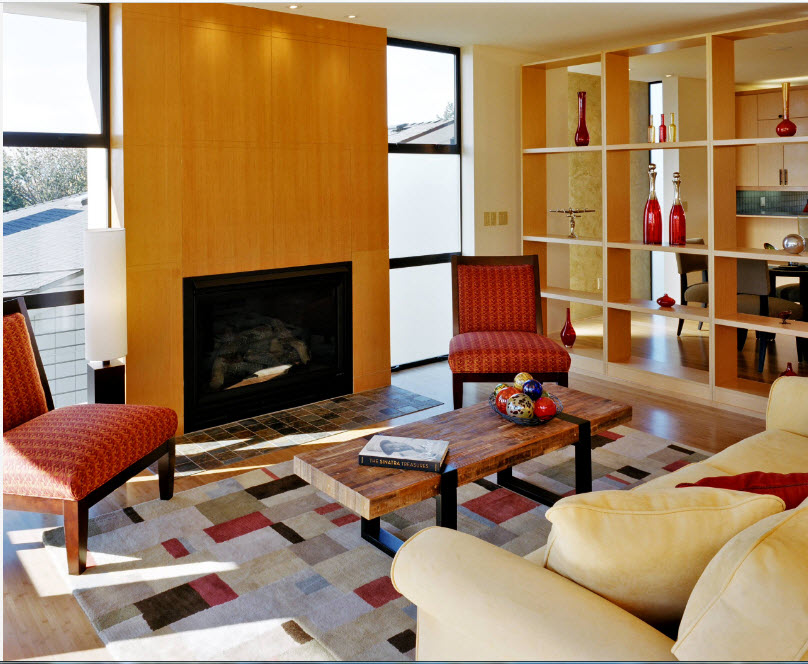
![]()
One of the options for using storage systems as partitions is the creation of a spacious cabinet. It is up to you to decide whether to place the storage systems on one or two sides, or whether it can use false facades in some places, use glass inserts or create a completely dull design.






The name speaks for itself - less durable surfaces are attached to supports made of durable material (metal, wood or laid out of bricks or blocks of columns) - screens (they can reduce the weight of the structure and reduce its cost, as well as bring an element of exclusivity into the image of the room). \\
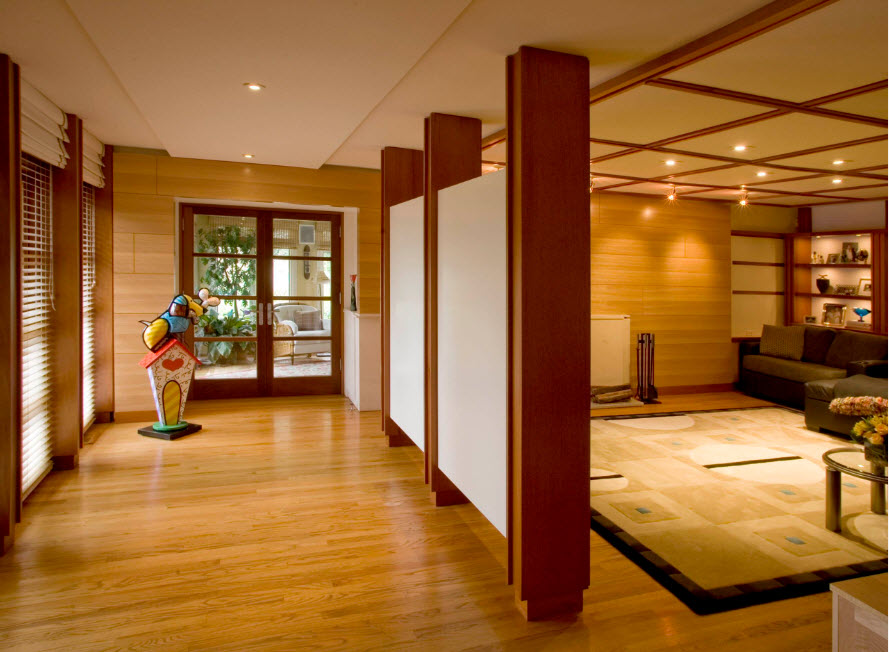
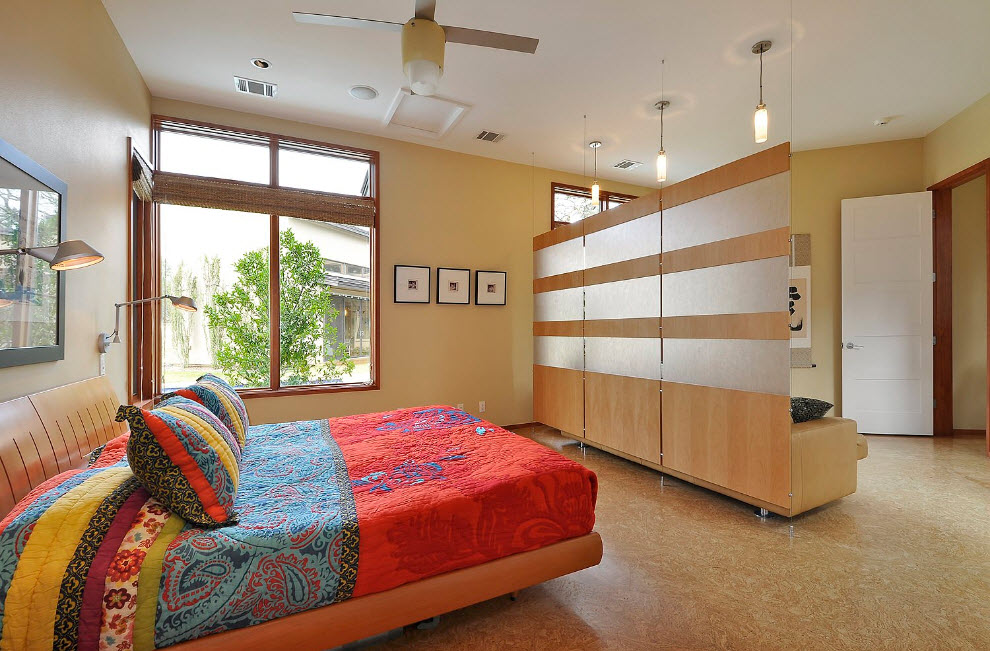
Interior partition-fireplace
The stationary interior partition in the form of a fireplace is a modern and very popular device, despite the fact that it requires considerable financial and time costs for the construction. Such a design hardly resembles ordinary partitions, because it has a very large width, sufficient to equip the air duct, chimney for the hearth. The obvious advantage of a double-sided fireplace is the ability to observe the flame dance in the hearth from different areas of the room.
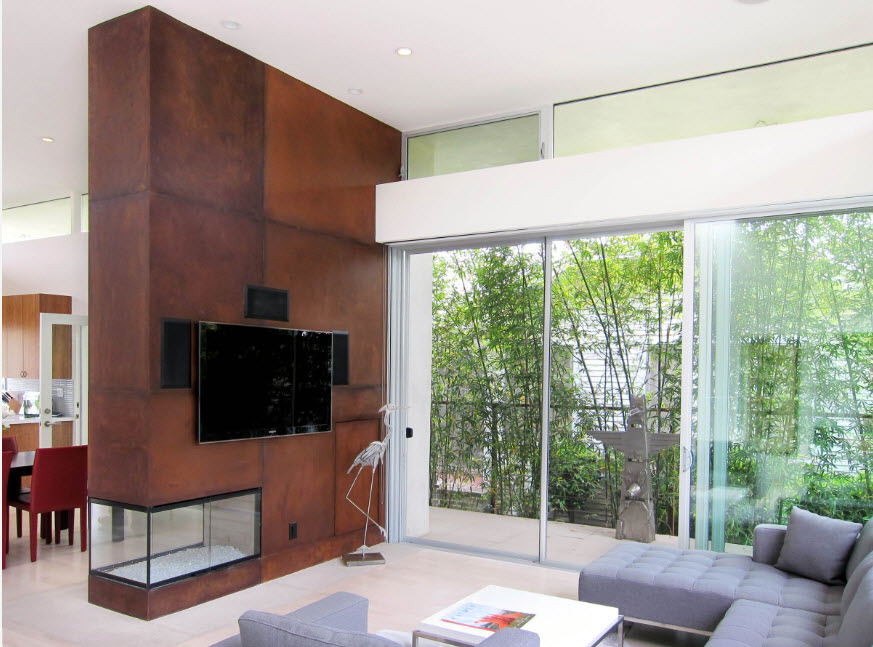


Swivel partitions
Original and at the same time incredibly functional device - swivel partitions. Designs look like horizontal blinds, capable of depending on the angle of rotation to create different levels of closure of a particular segment of the room.
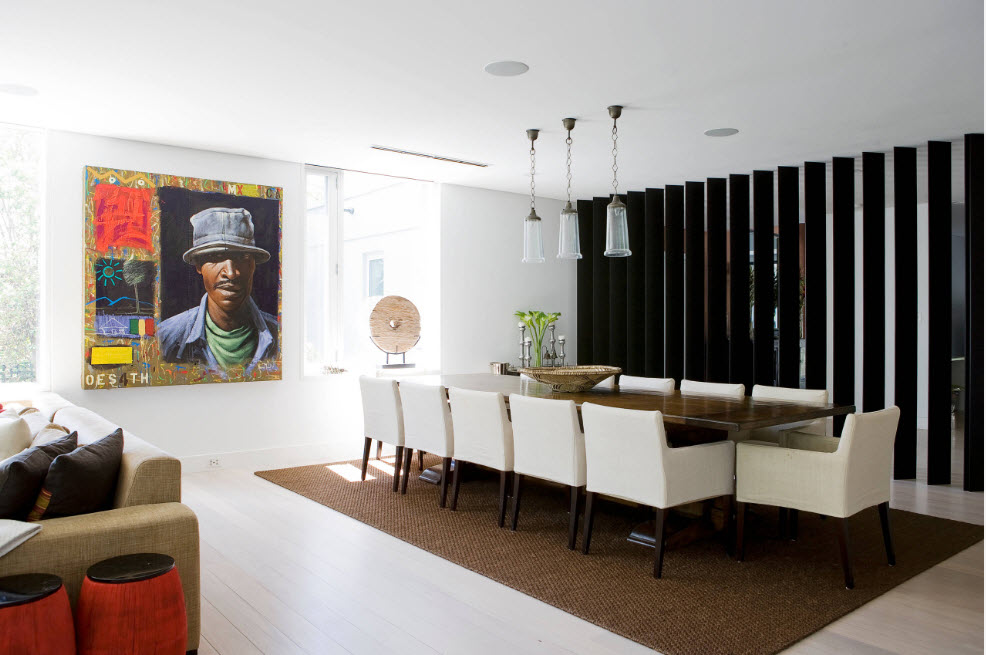

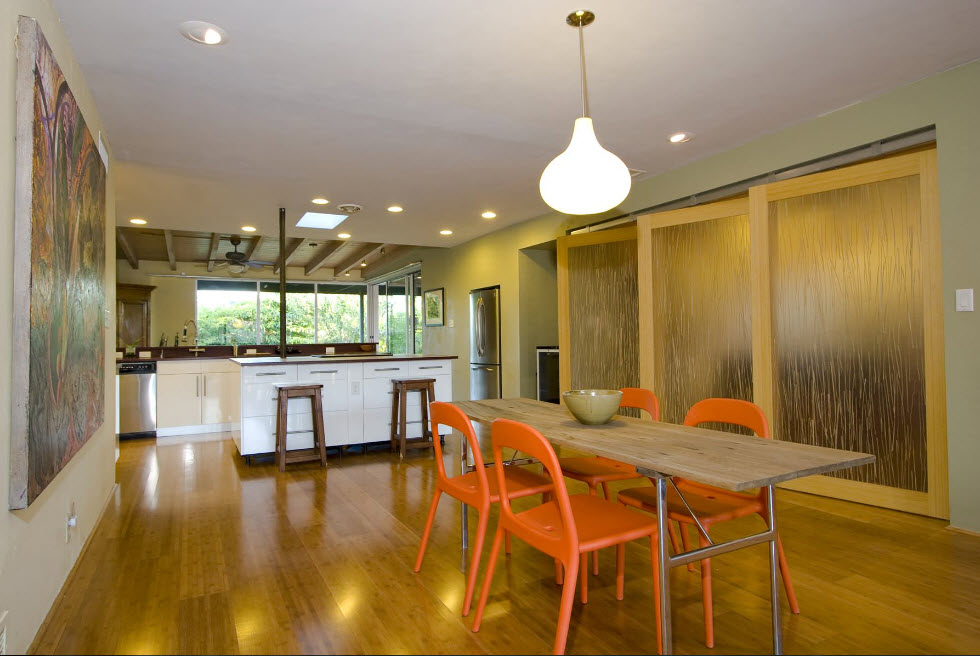
Supports
One of the options for interior partitions, which are created not only for the zoning of rooms, but also to create support for any element of the interior, are structures on which steps and other parts of stairs are based. Most often, such partitions are made of wood or metal. It is extremely rare that they are performed in a continuous form, most often such partitions have holes, perforations.
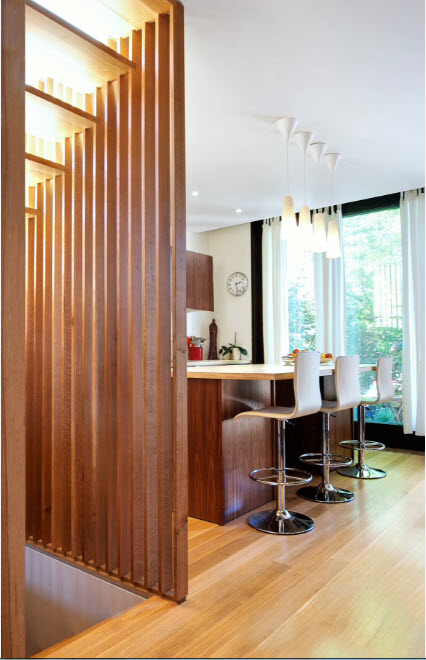

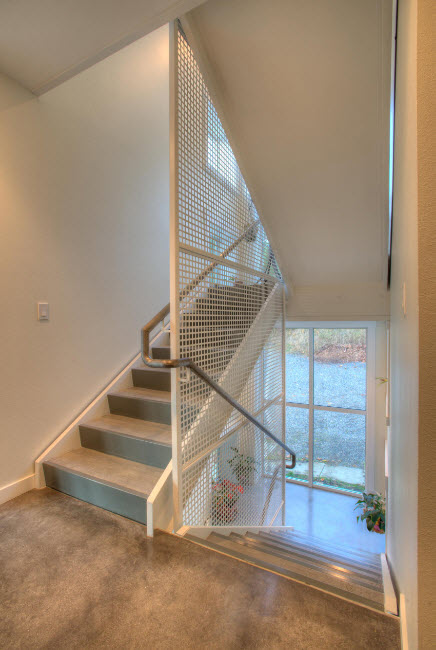

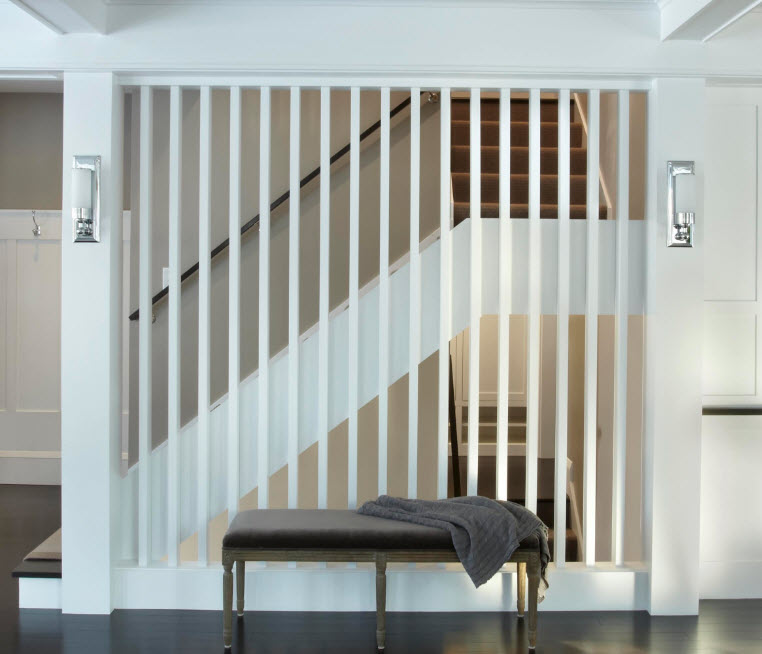
The partition can serve as a support for various consoles and countertops, storage systems and even seats. It all depends on the purpose of the room in which the multifunctional element of the interior is located.


Partition - a decorative element
Often, the interior partition acts not so much as a protecting surface, but as a decorative element. Indeed, for the embodiment of the imagination of the designer or the owners of apartments and houses, there are currently practically no boundaries. It all depends on your preferences, the chosen concept of interior design and financial capabilities.
